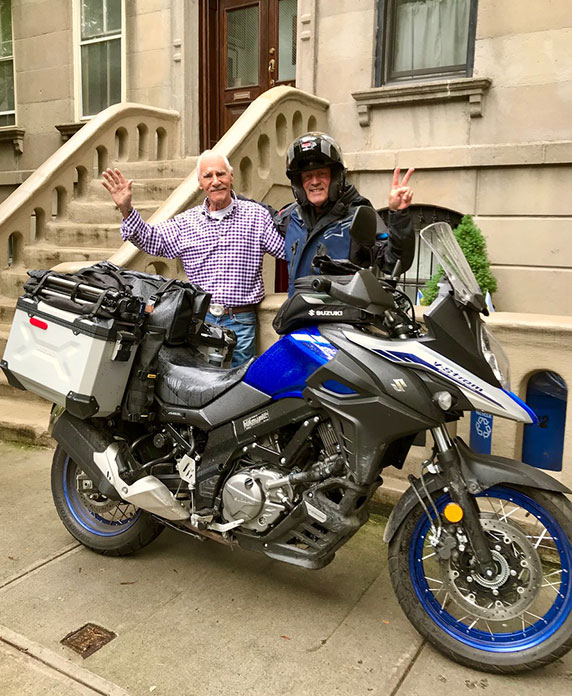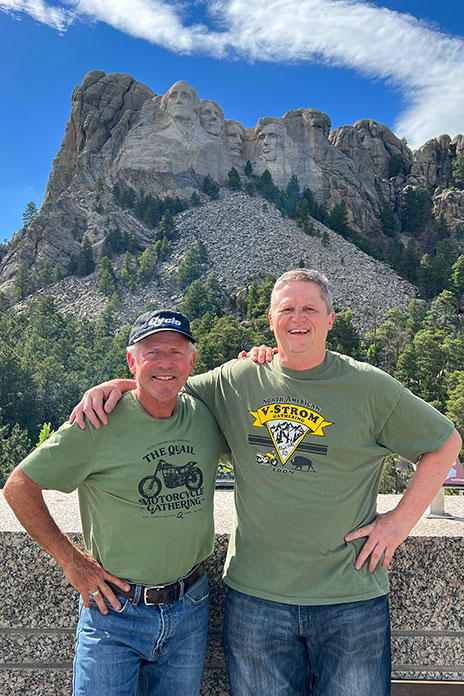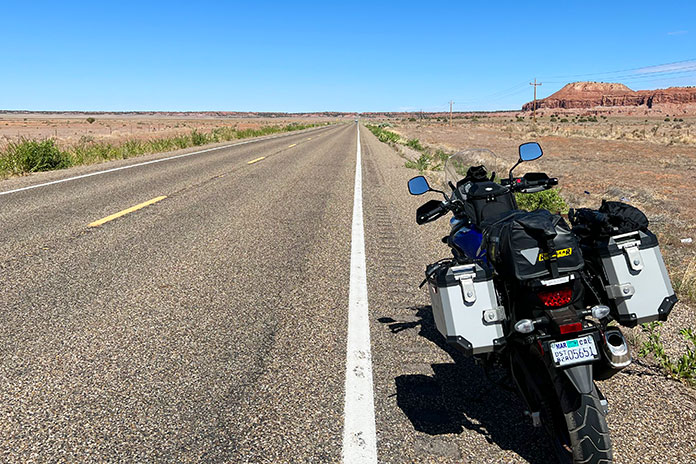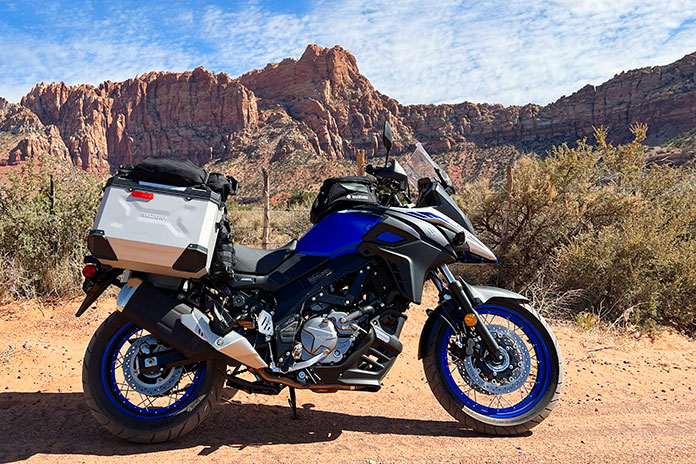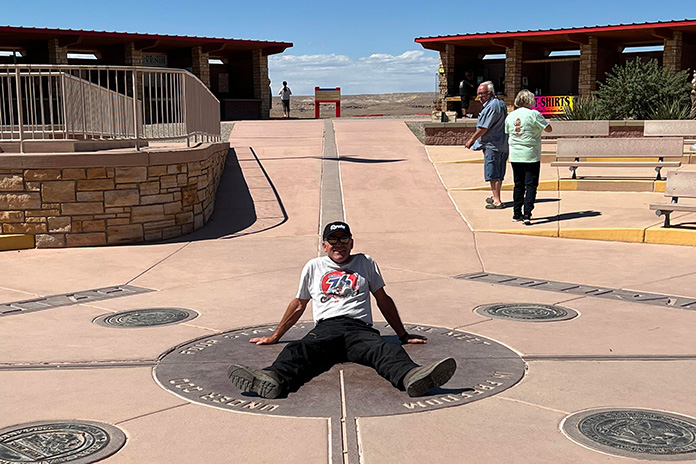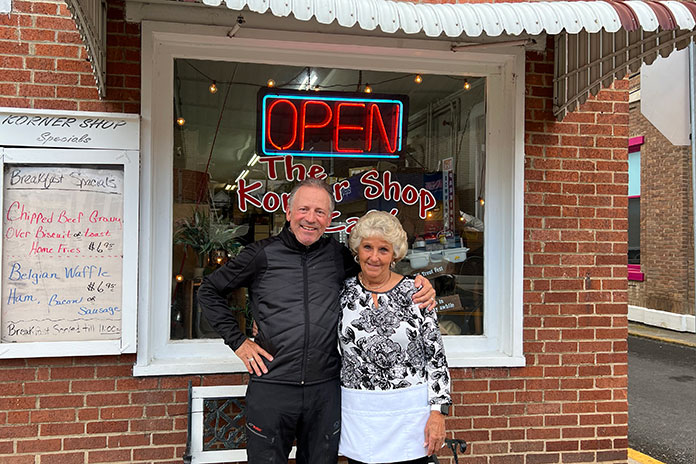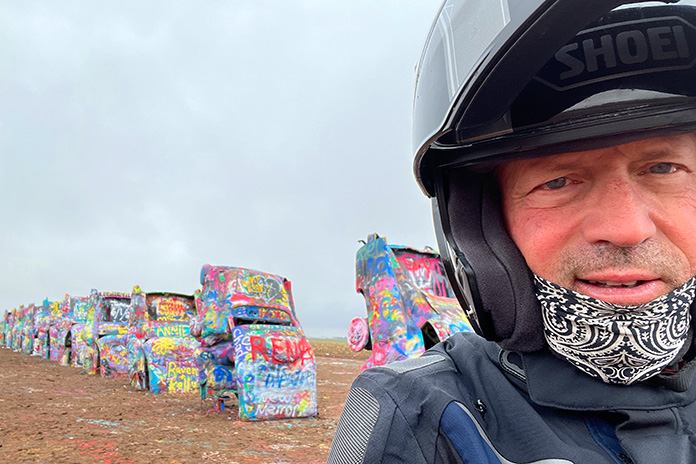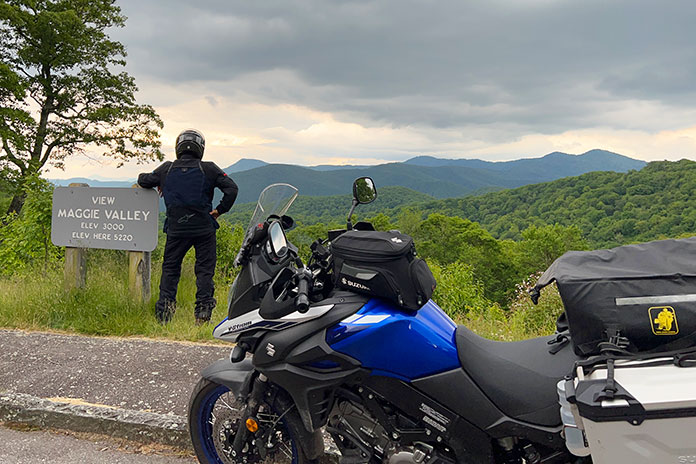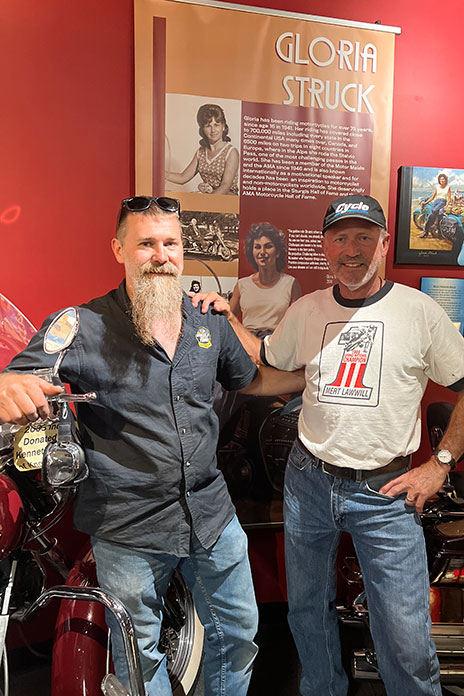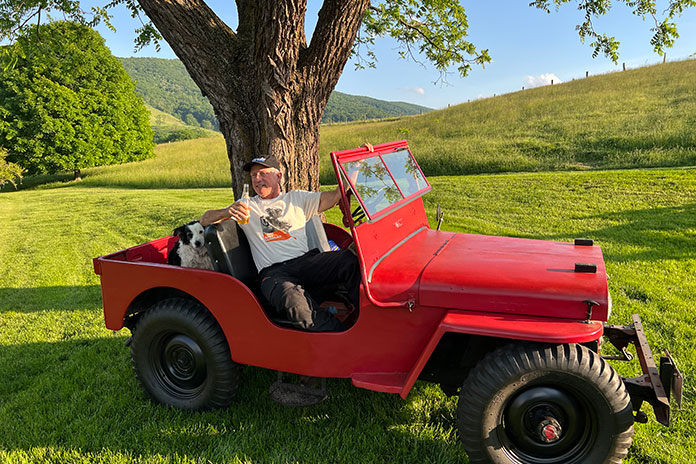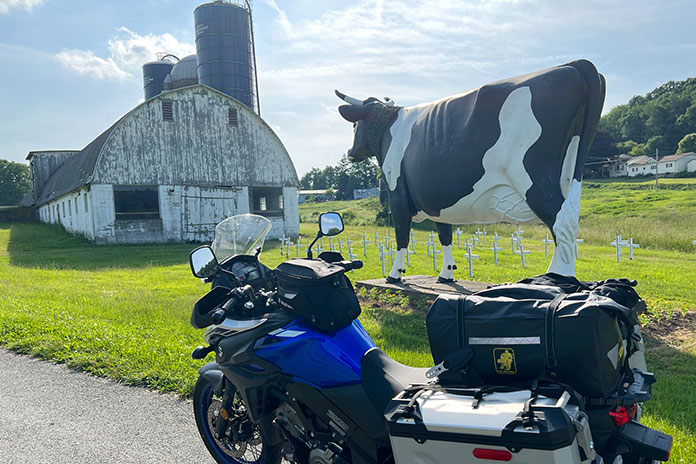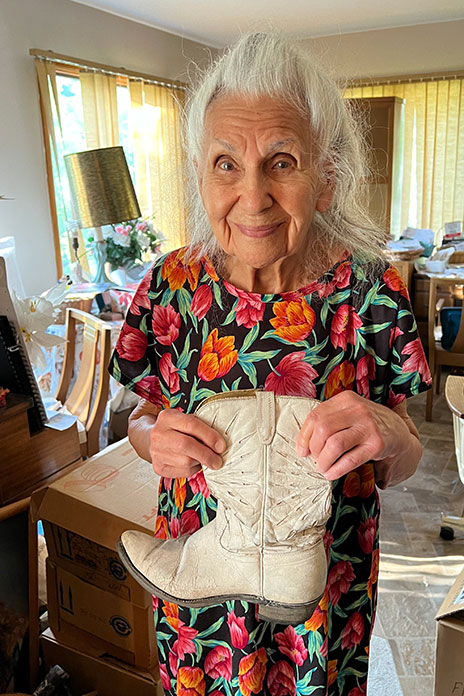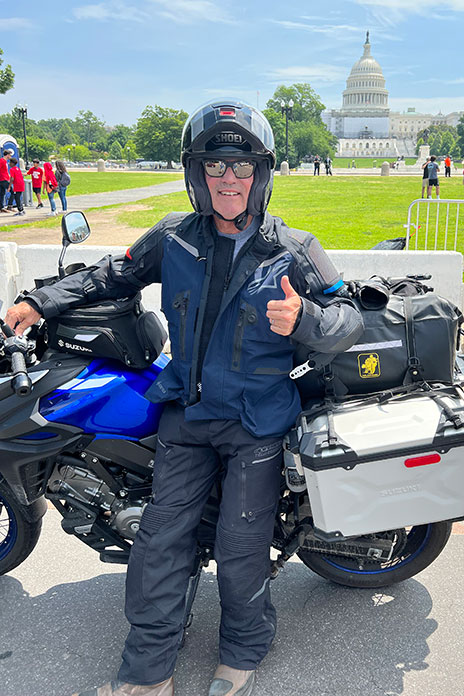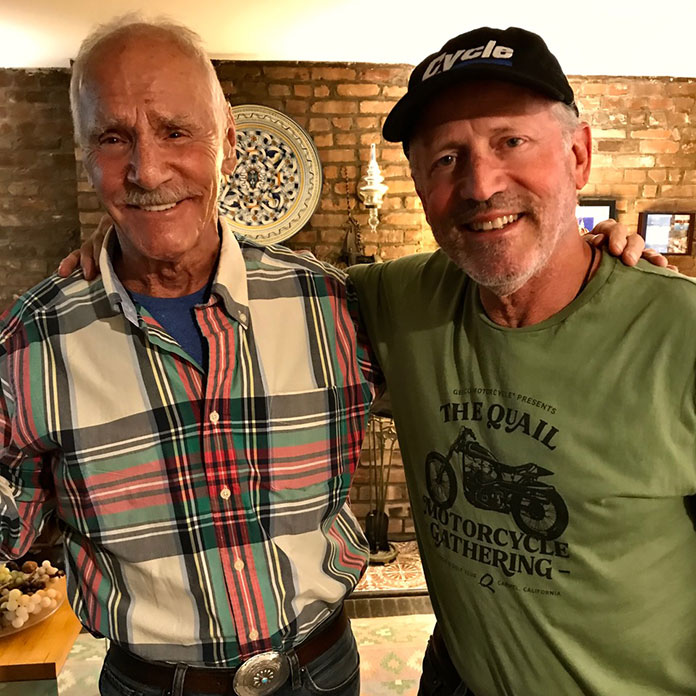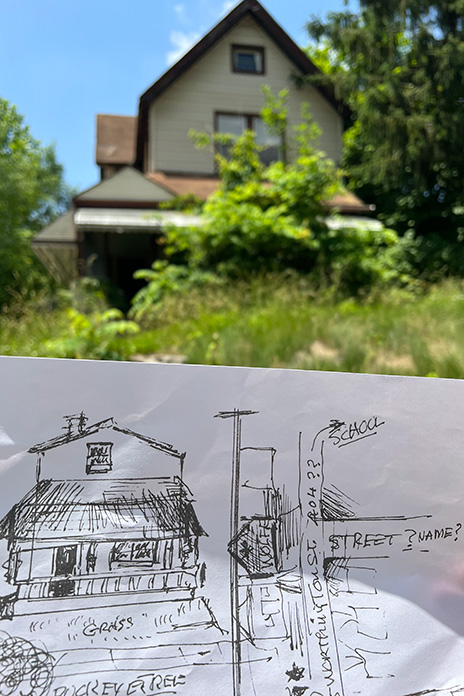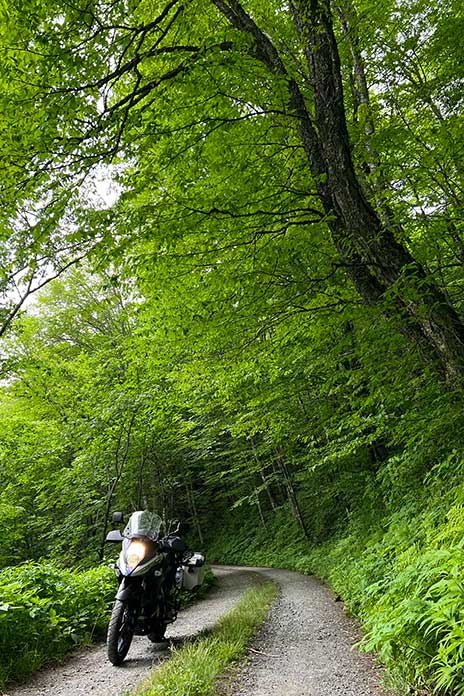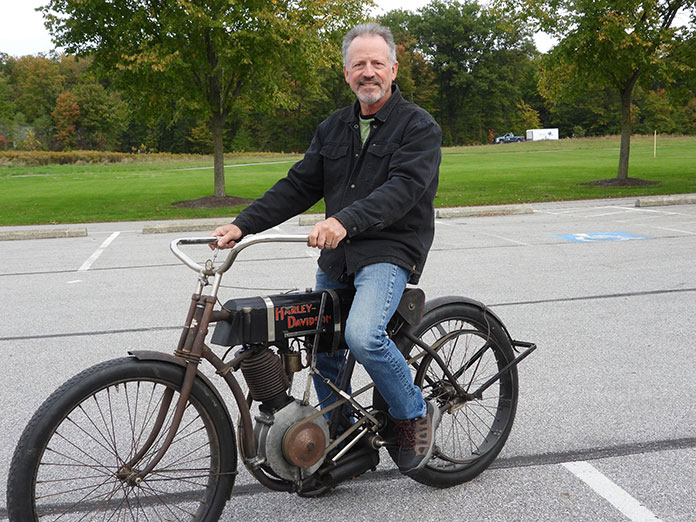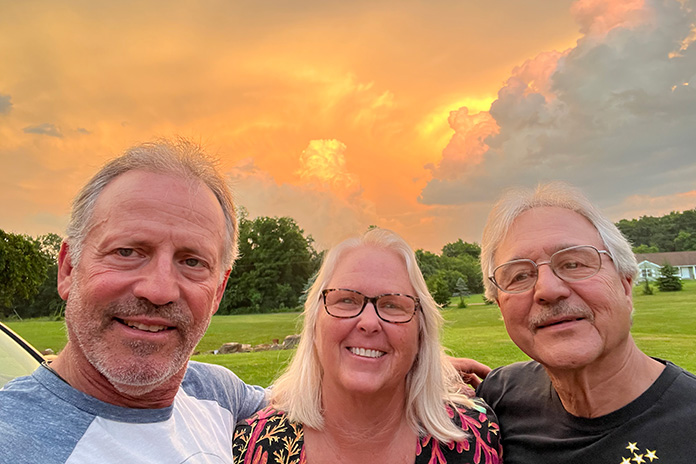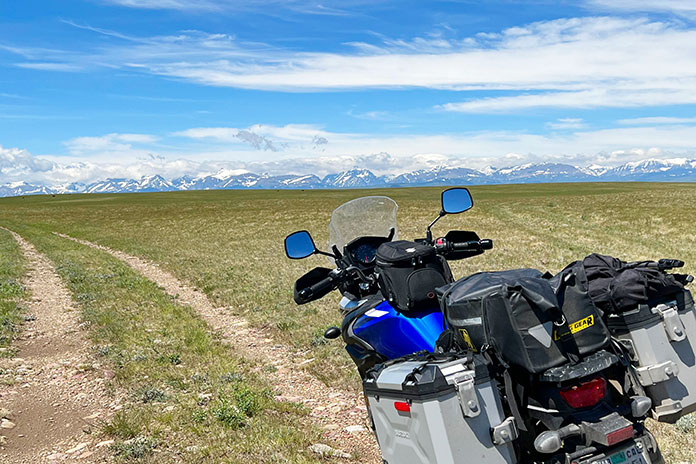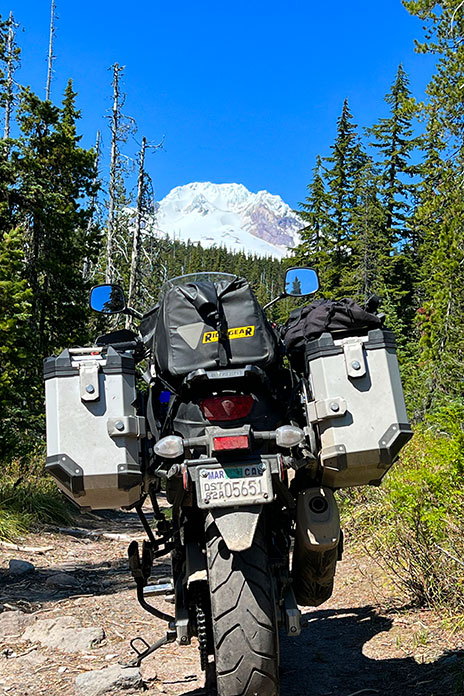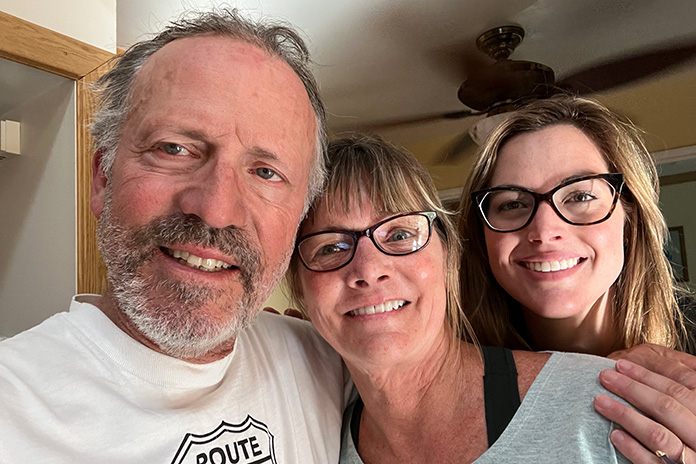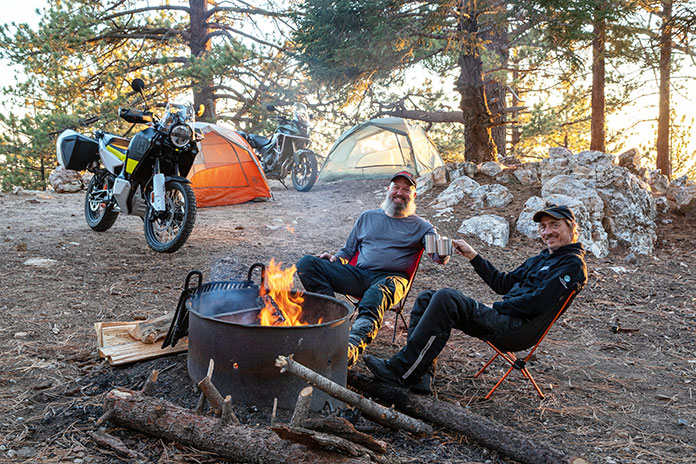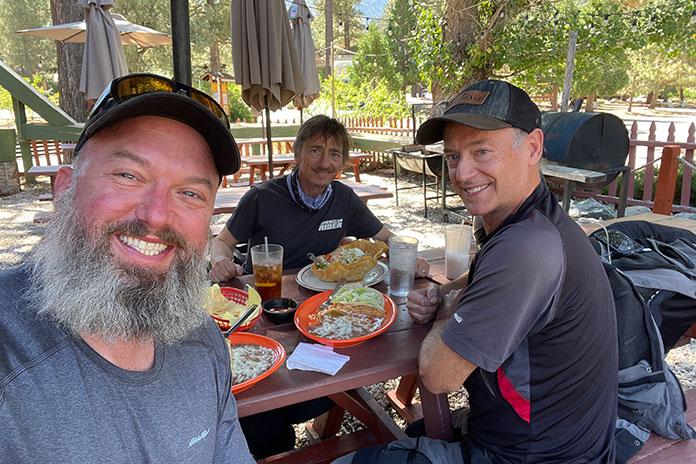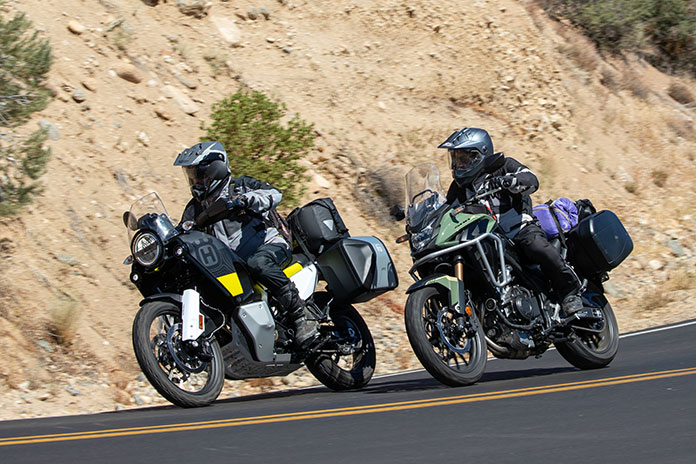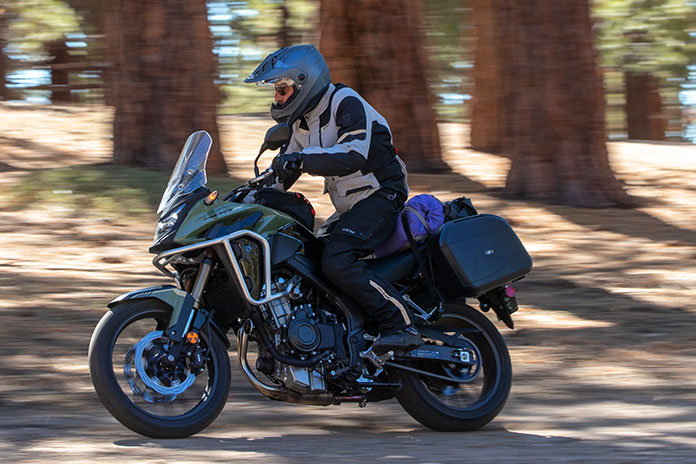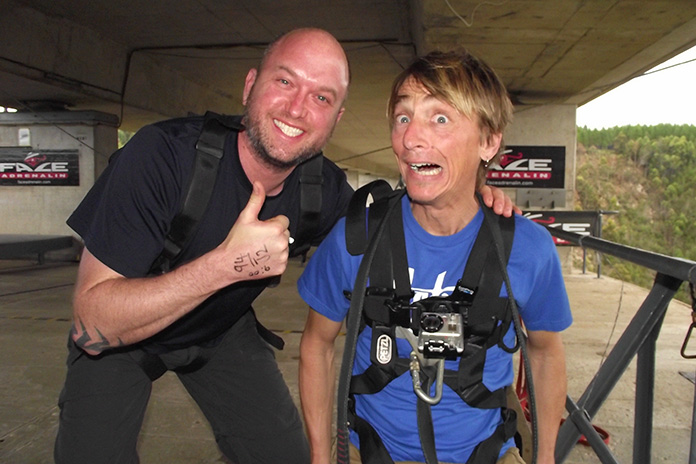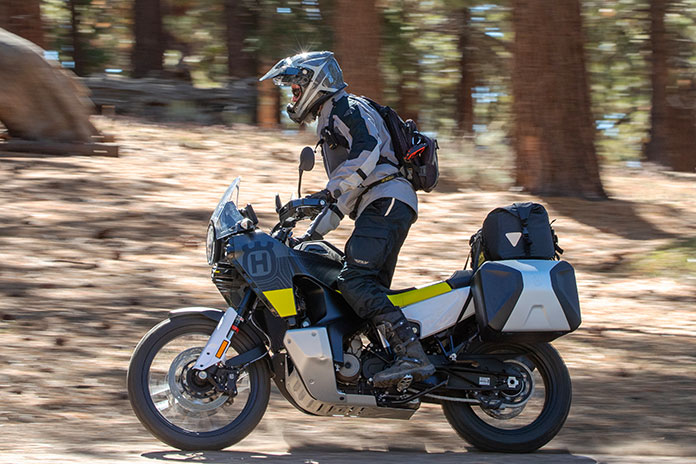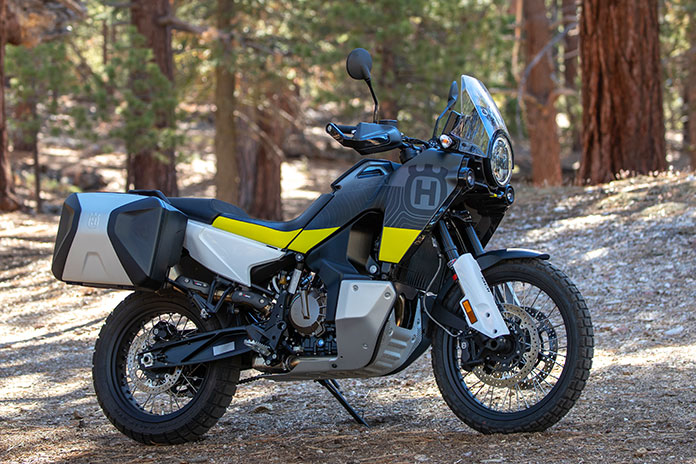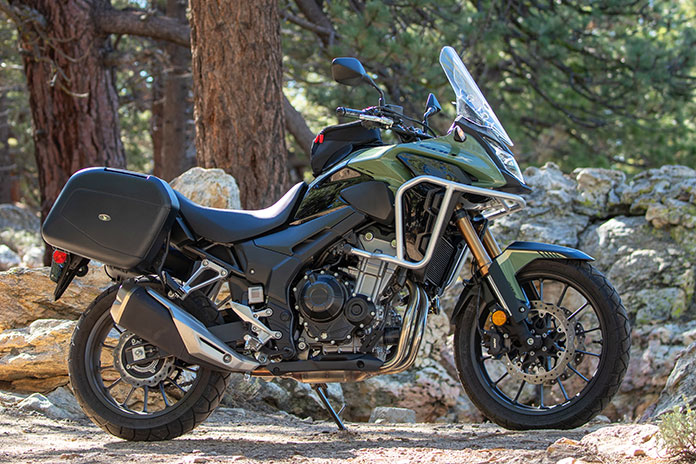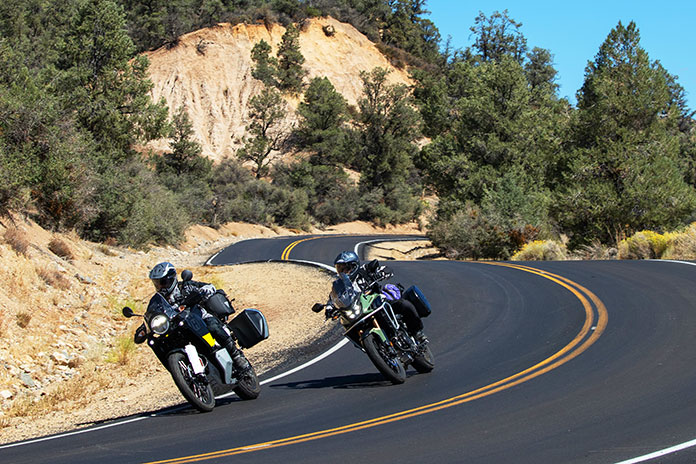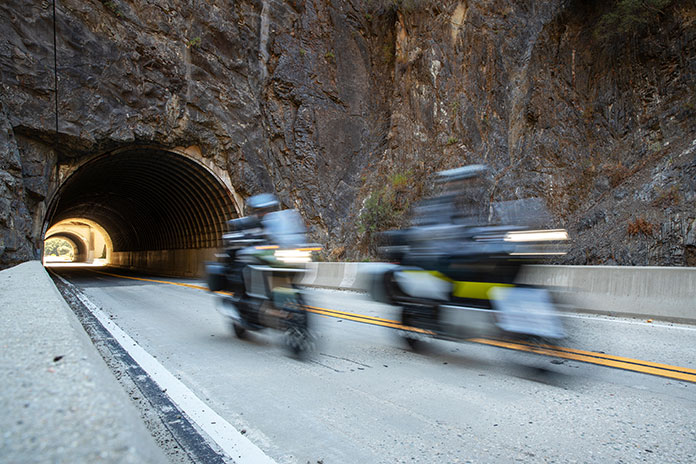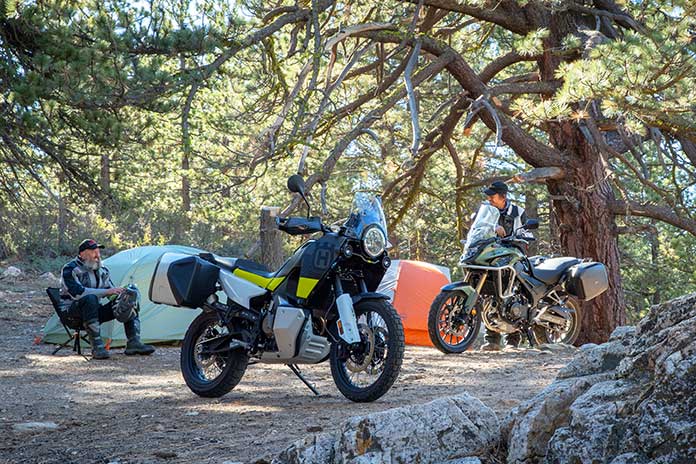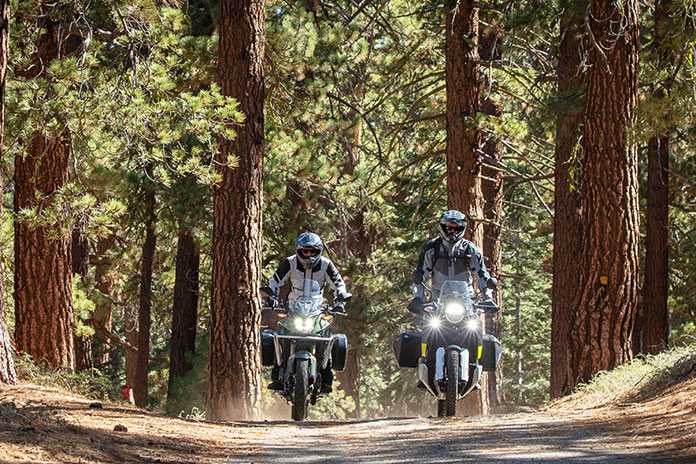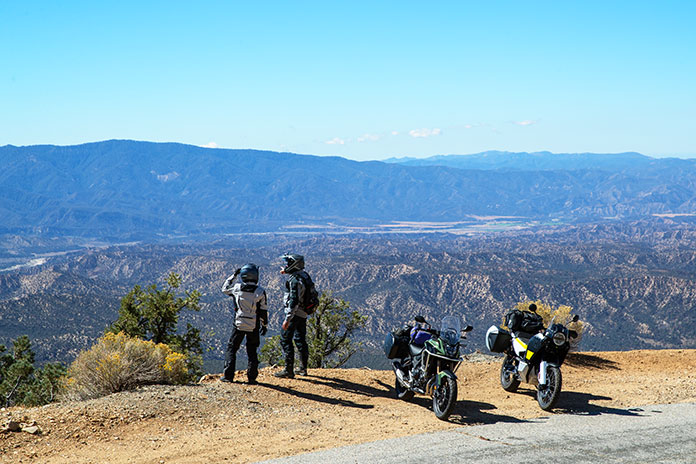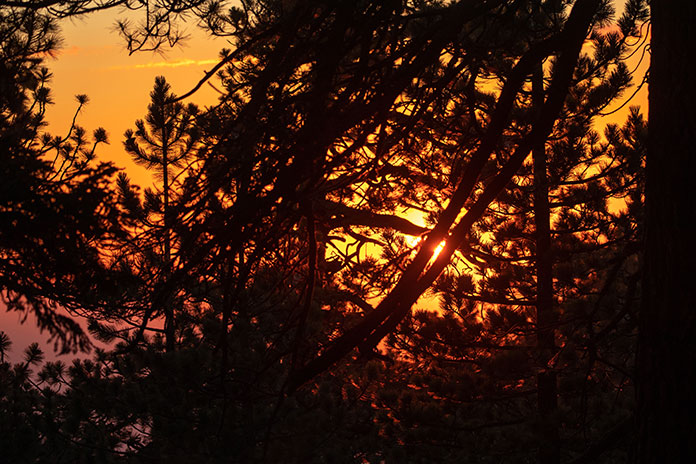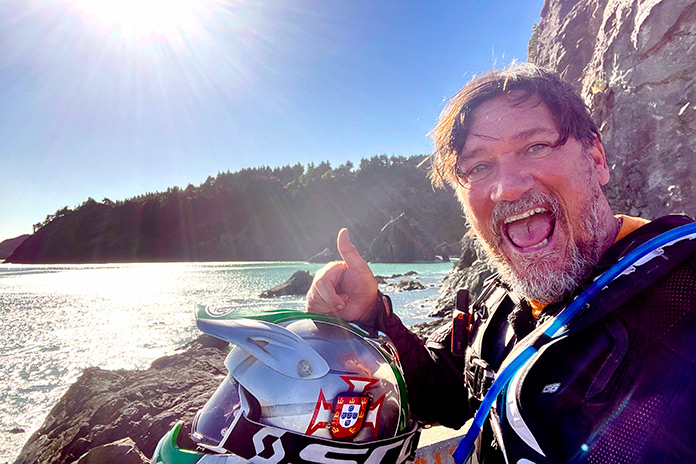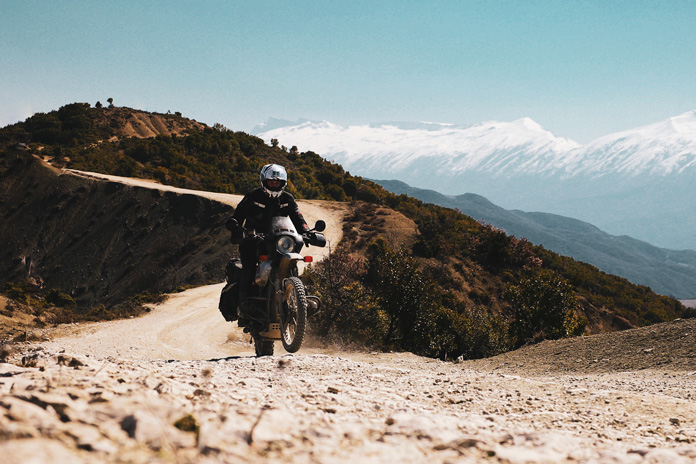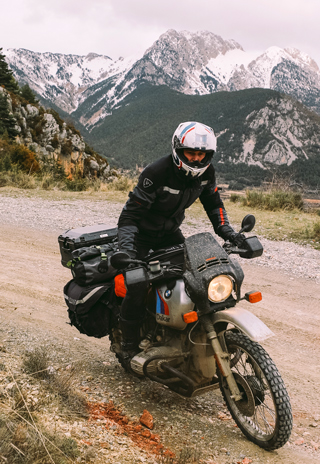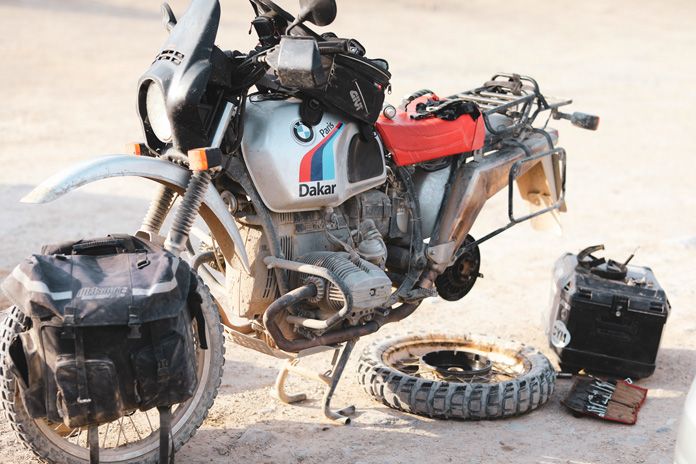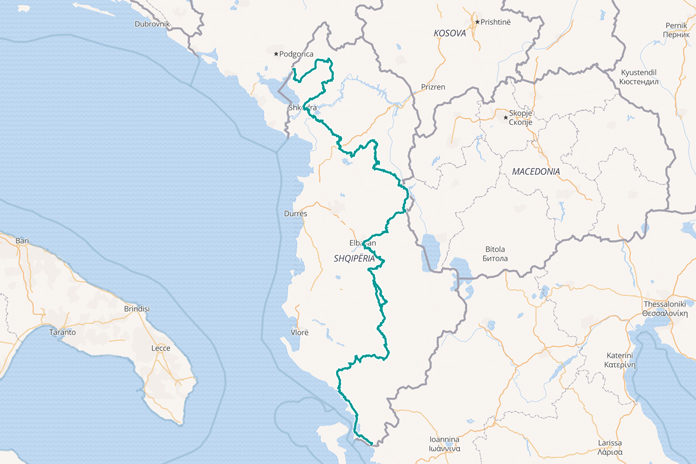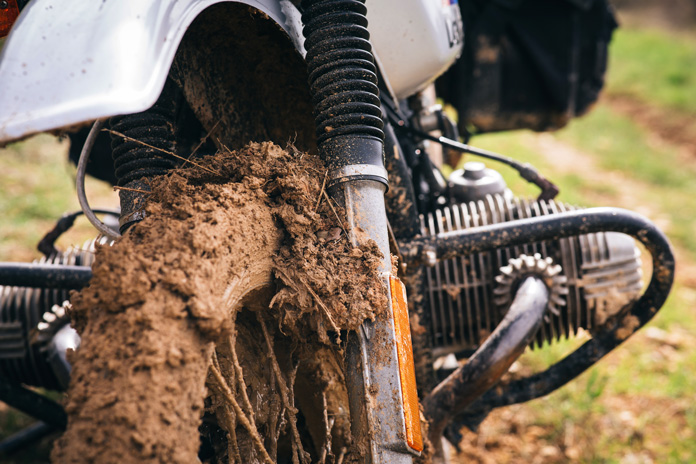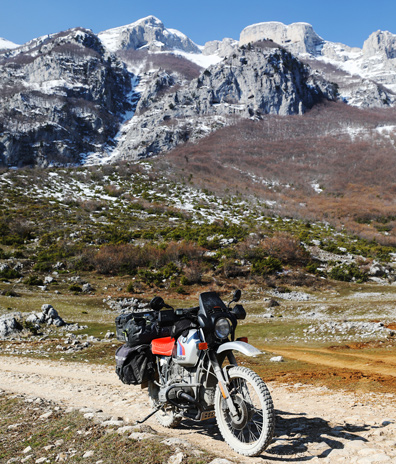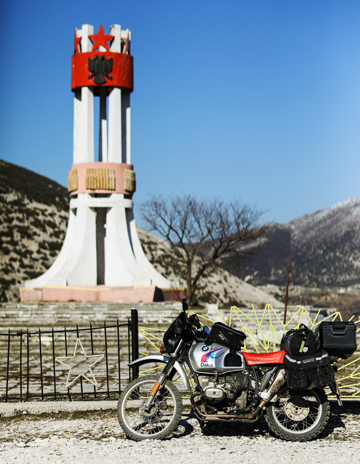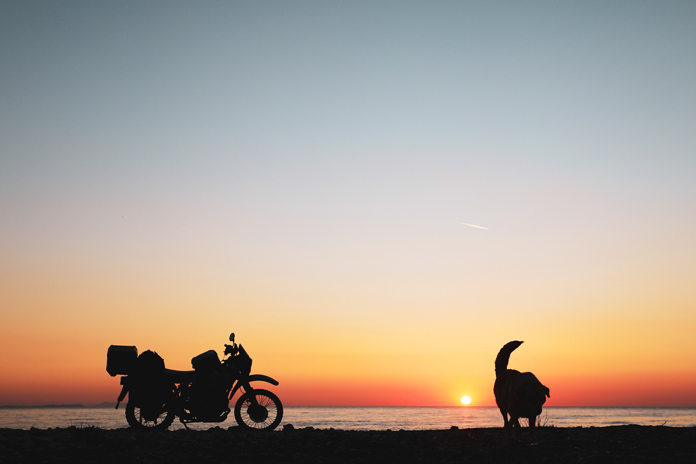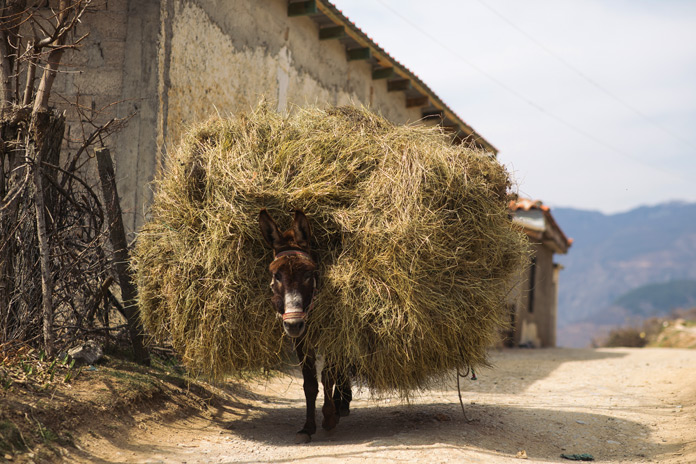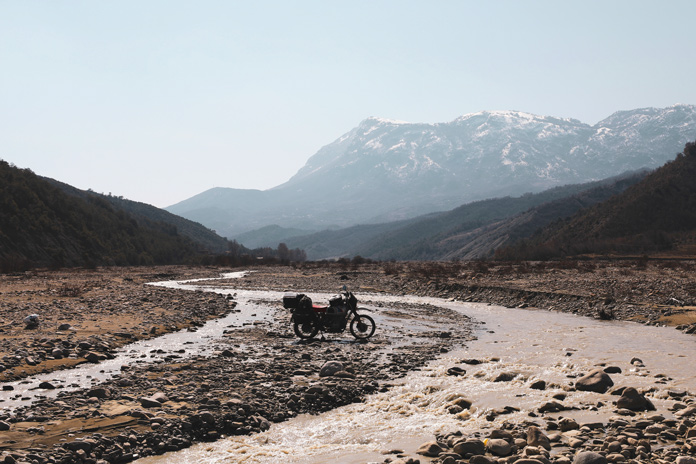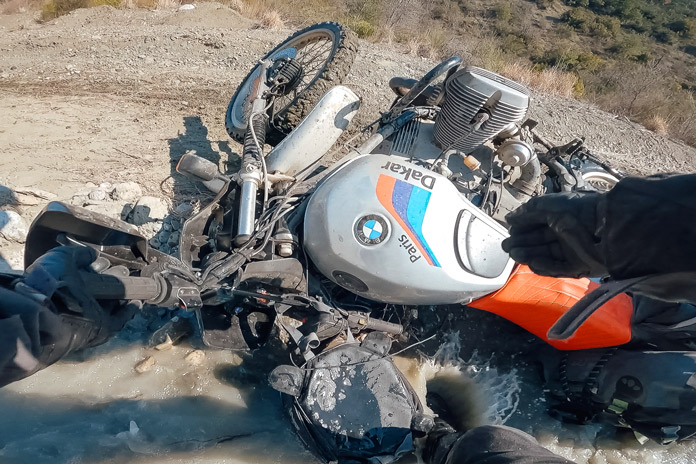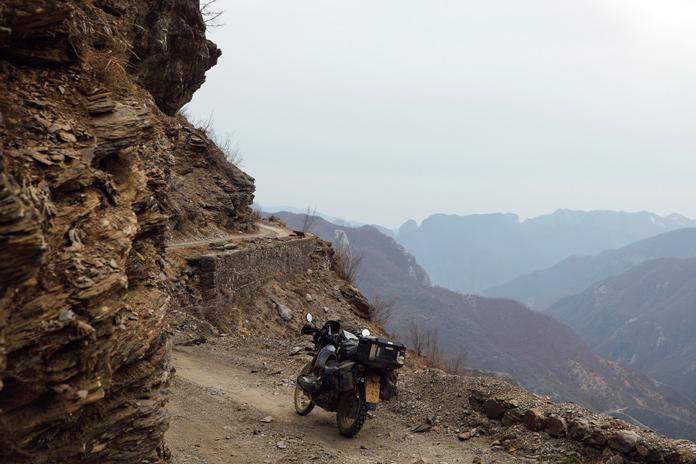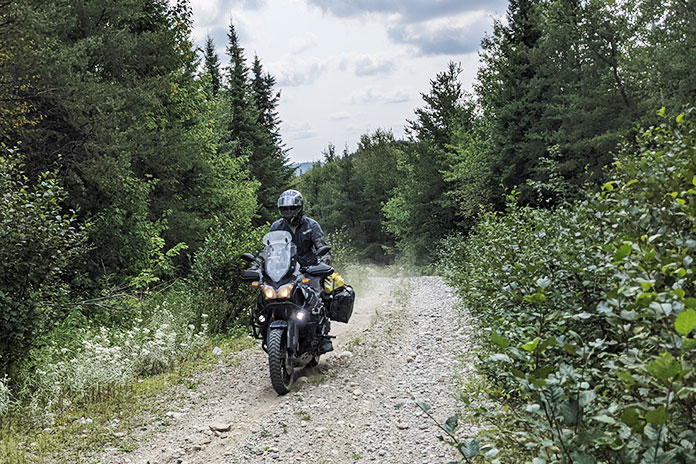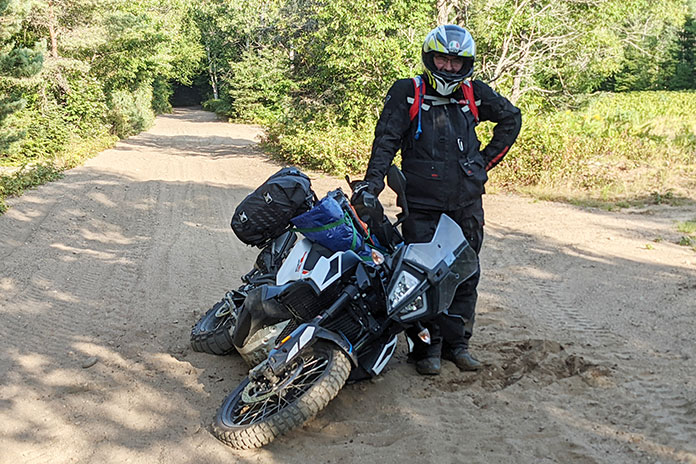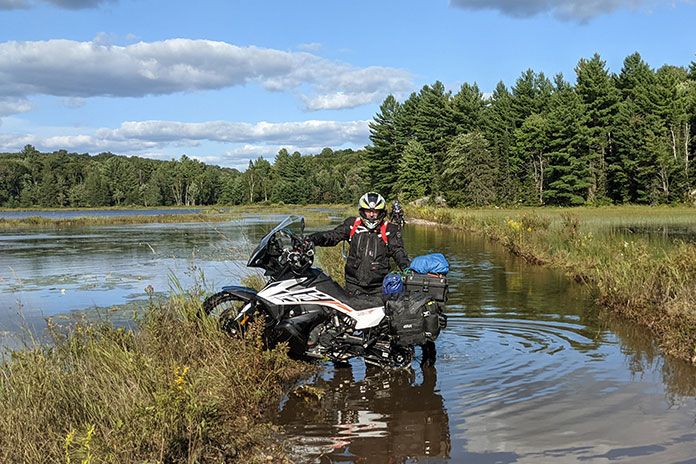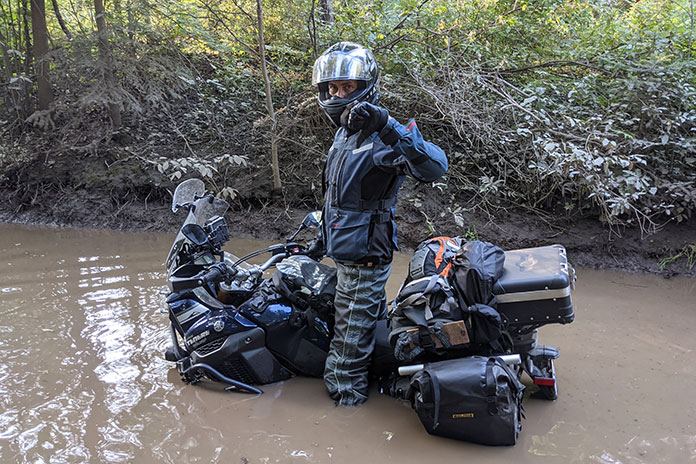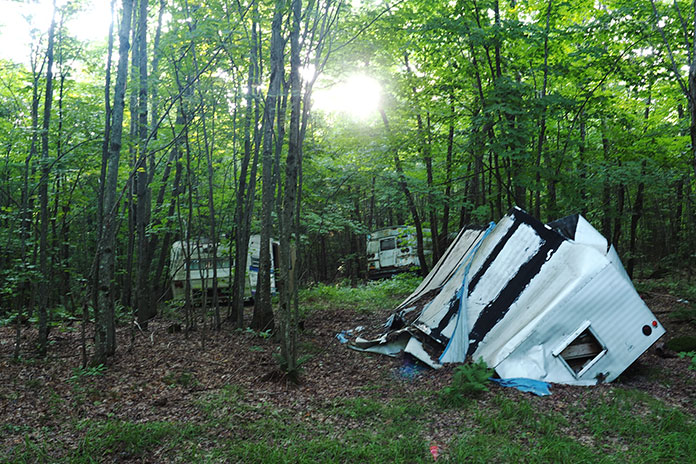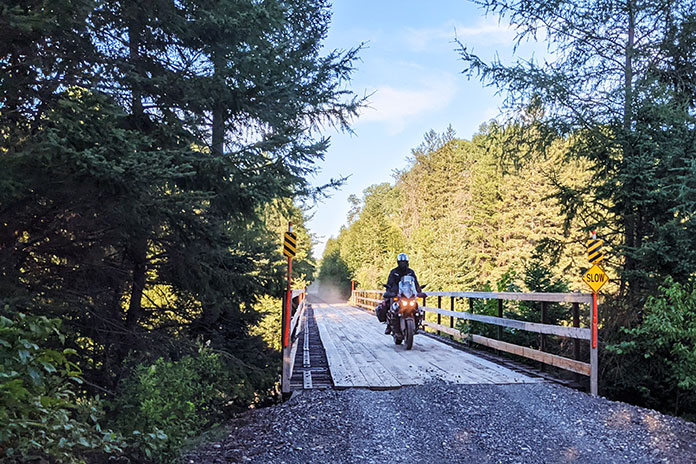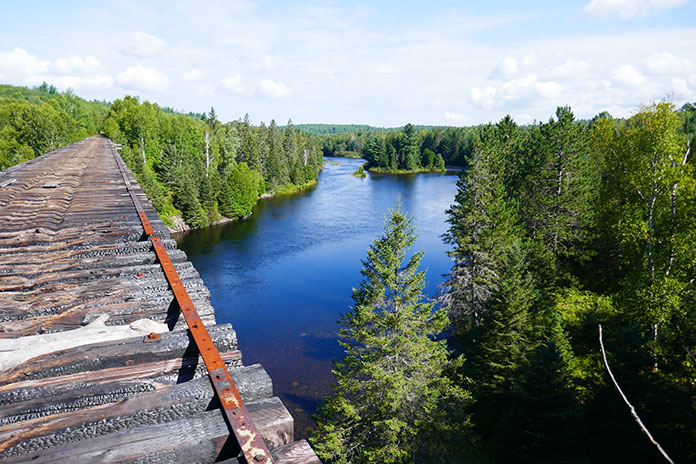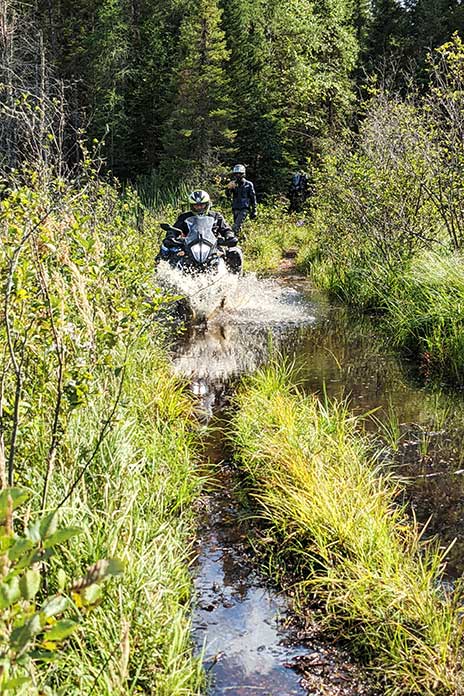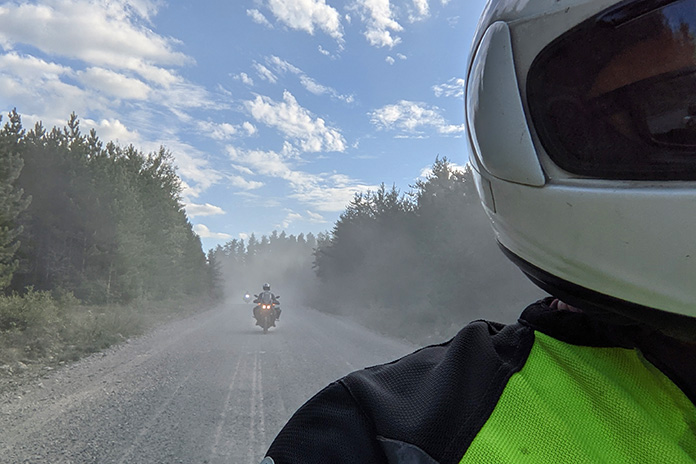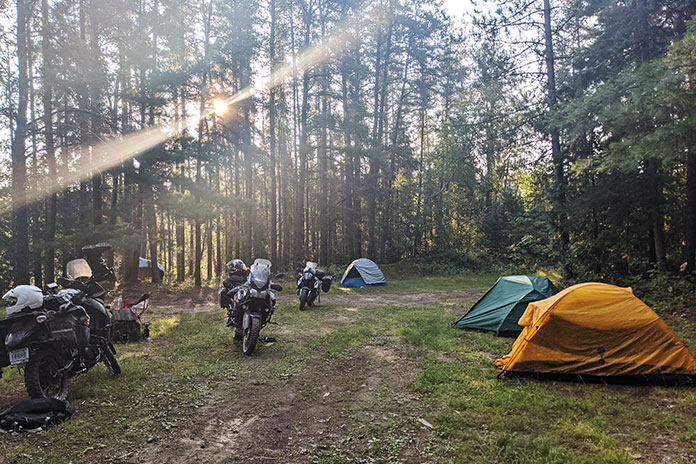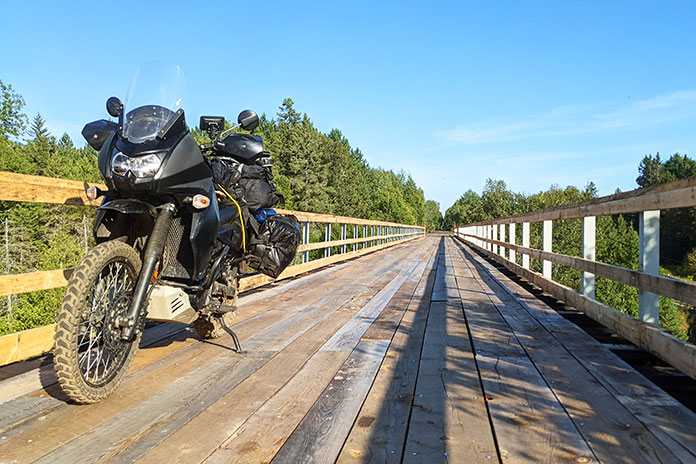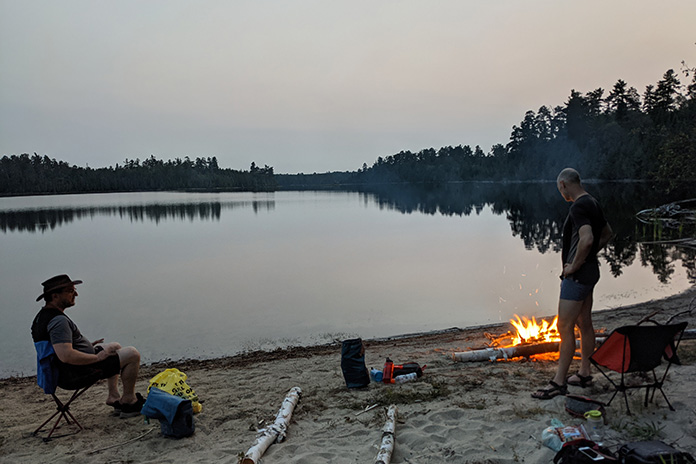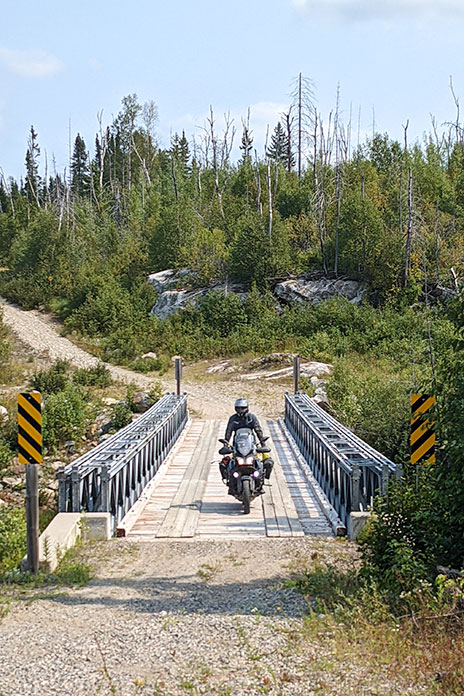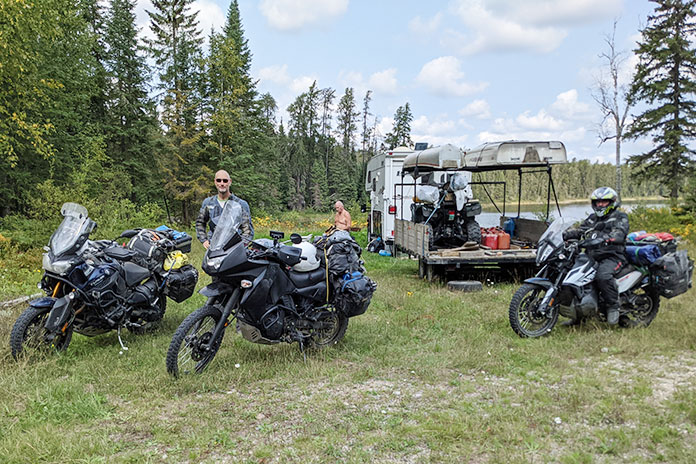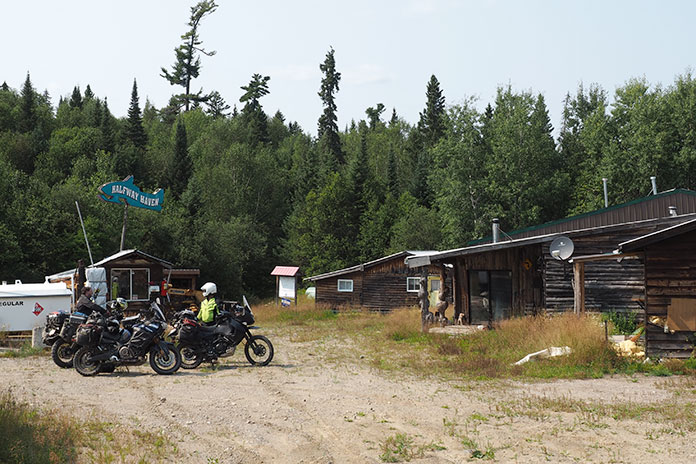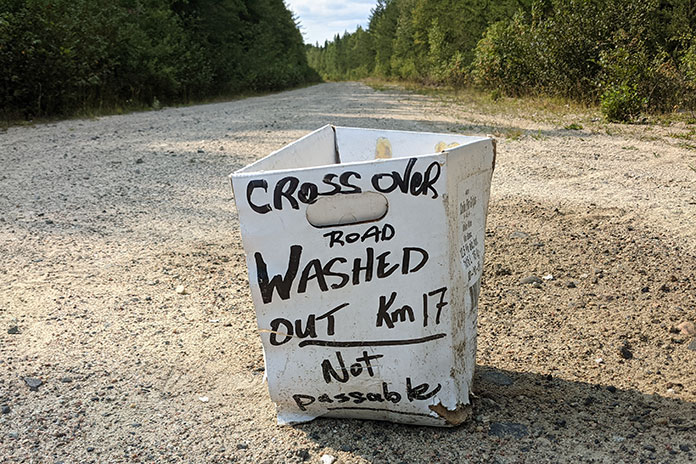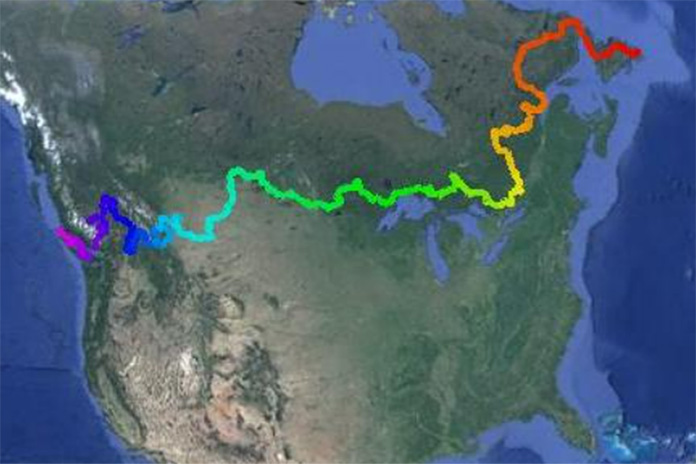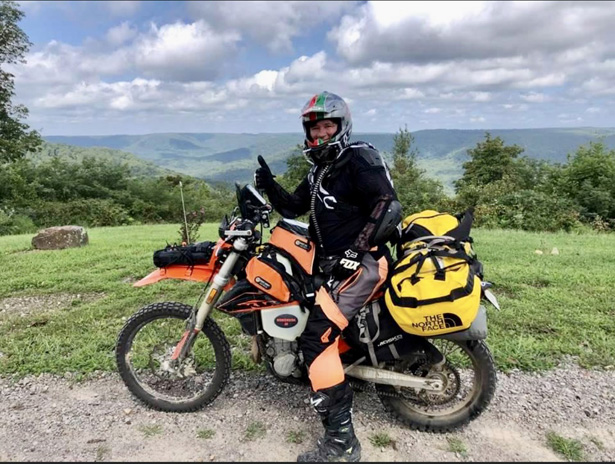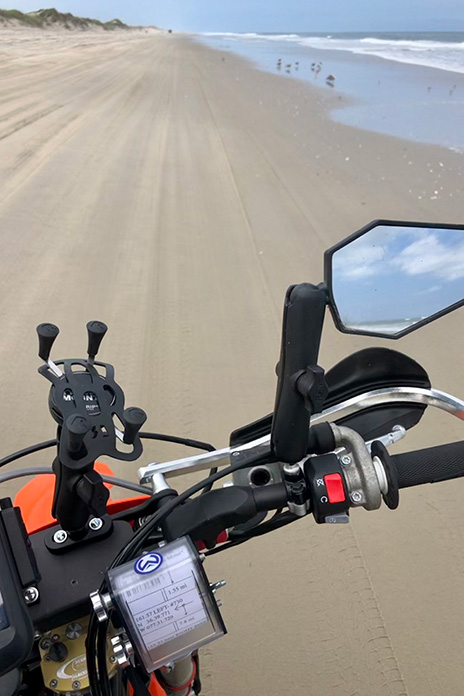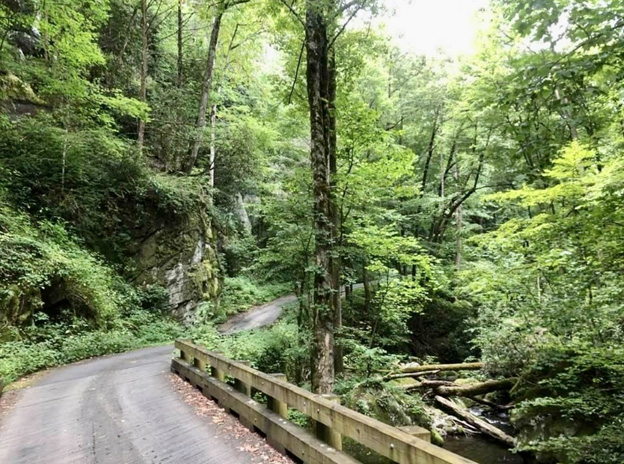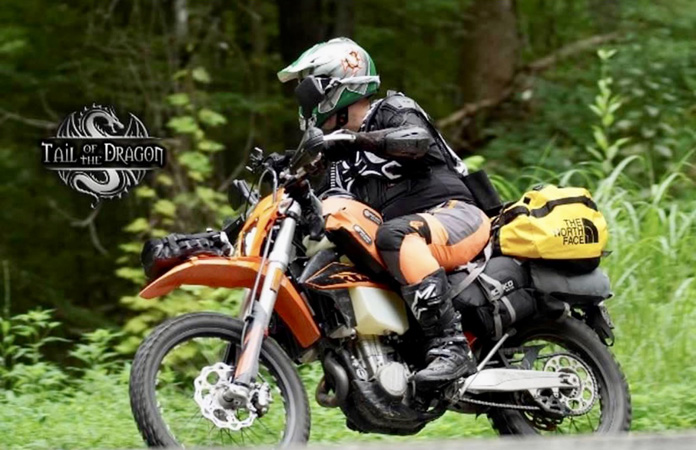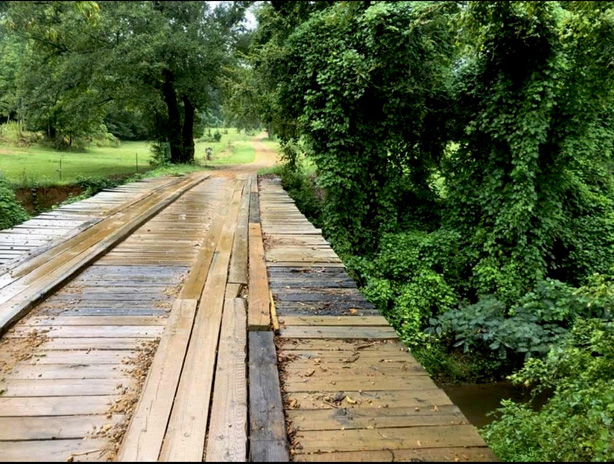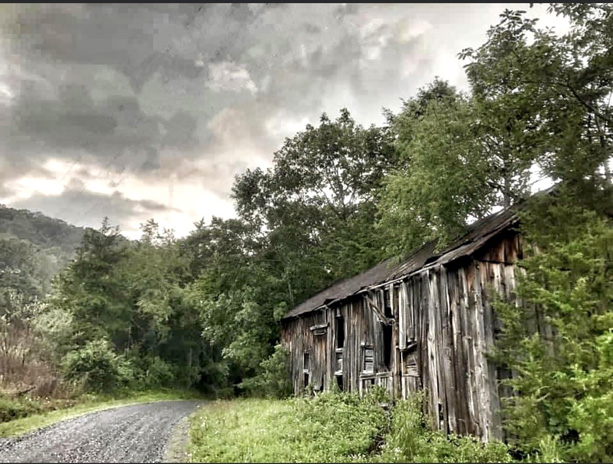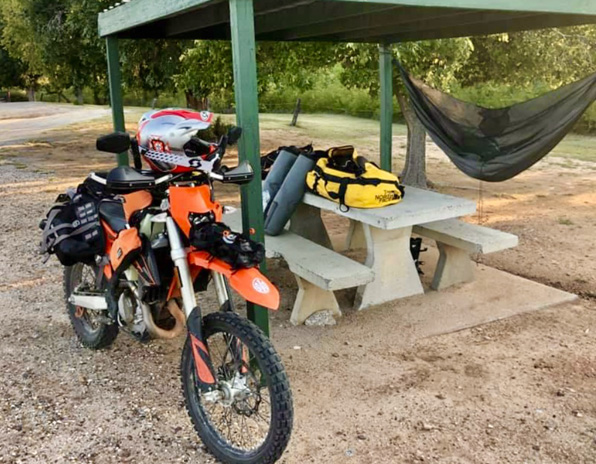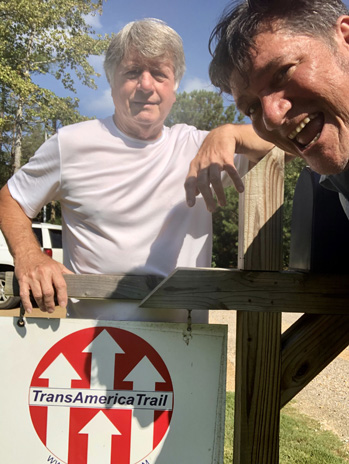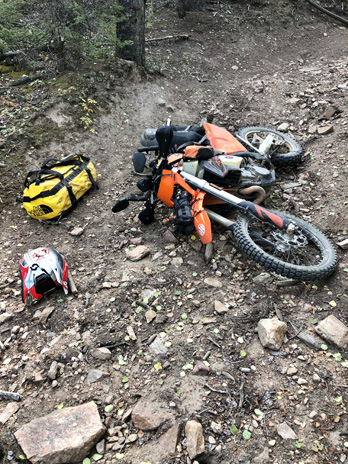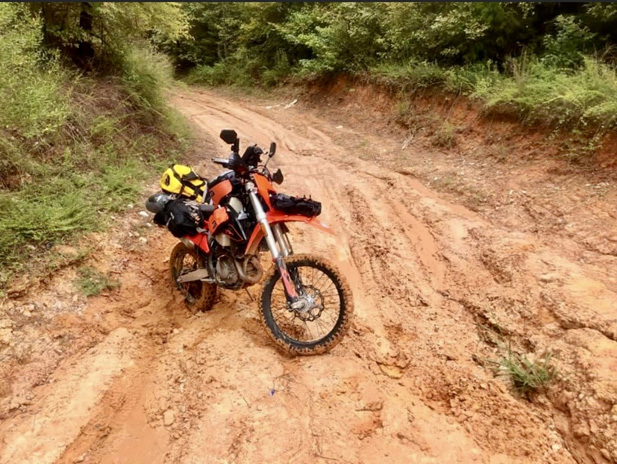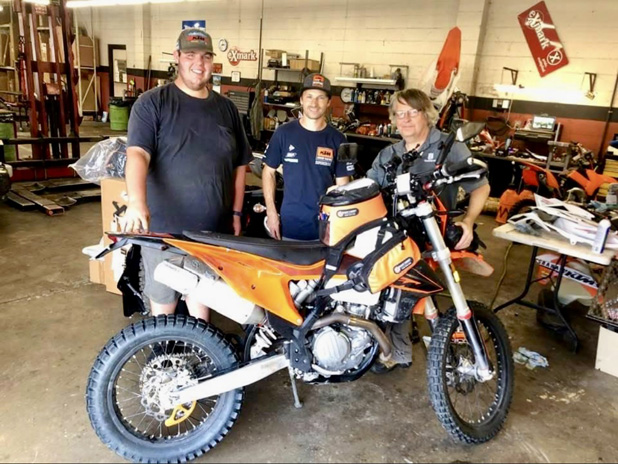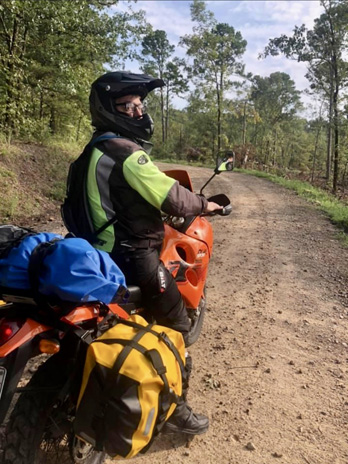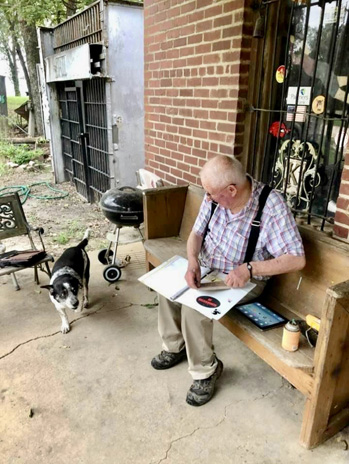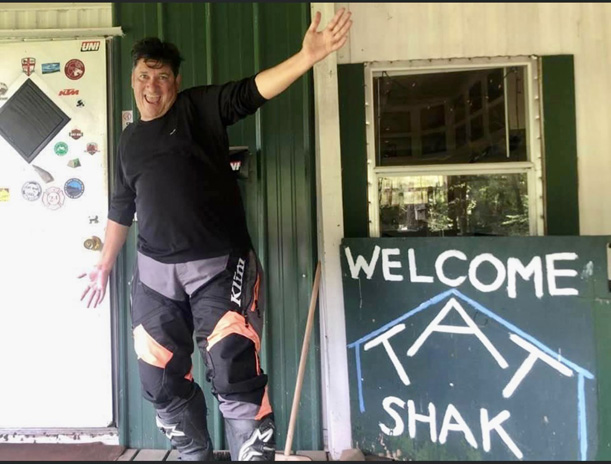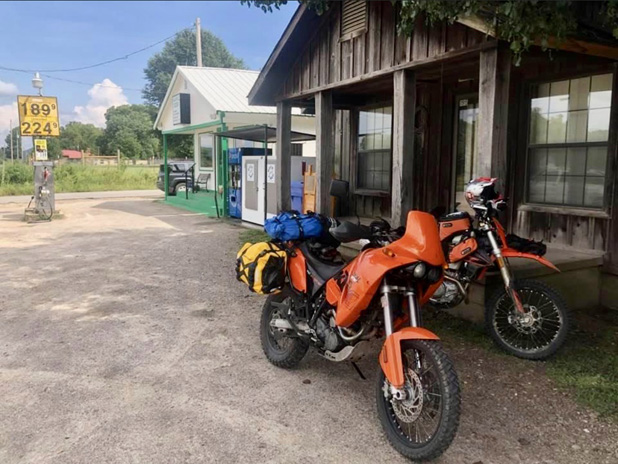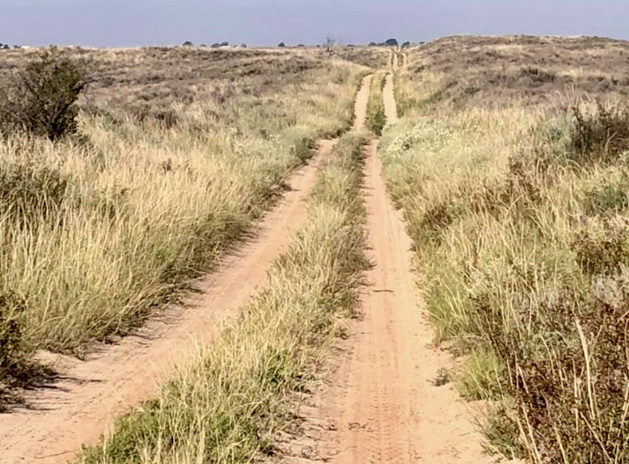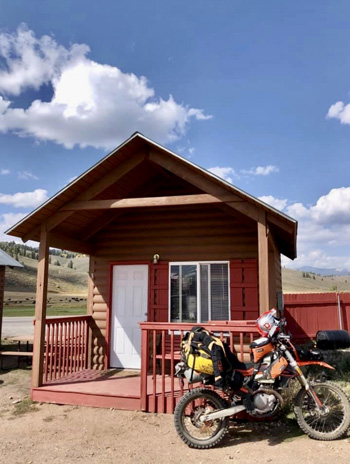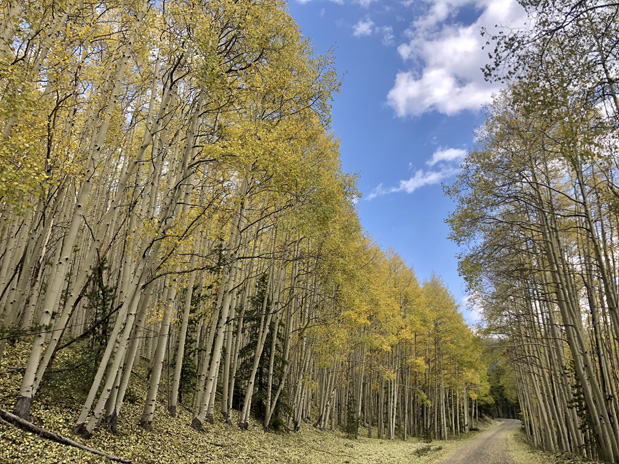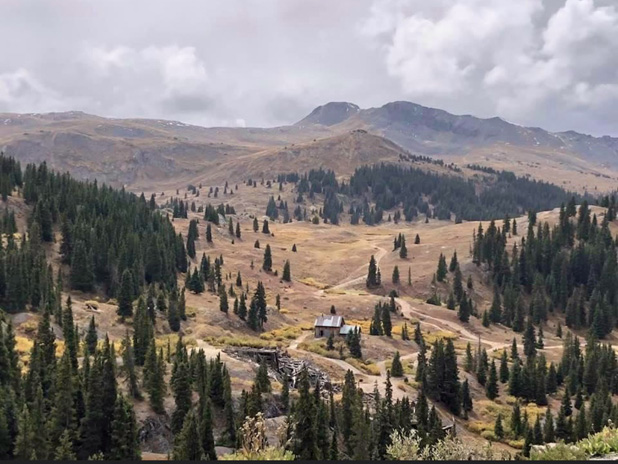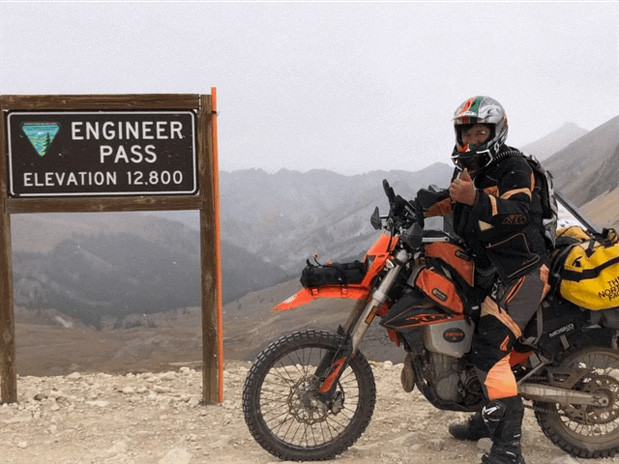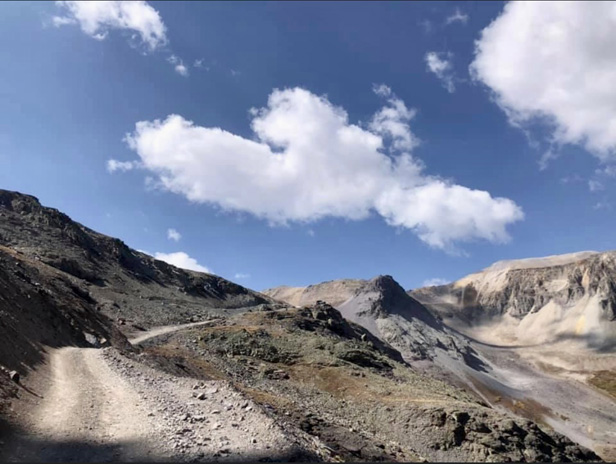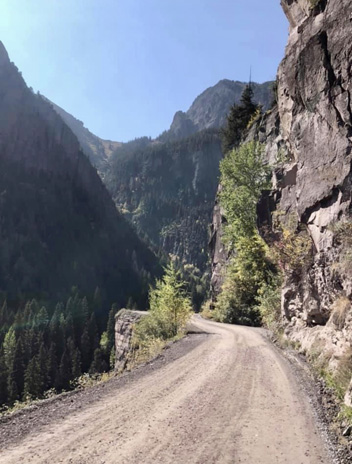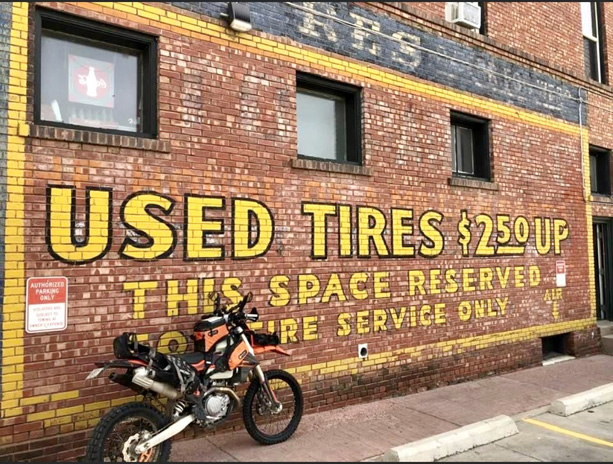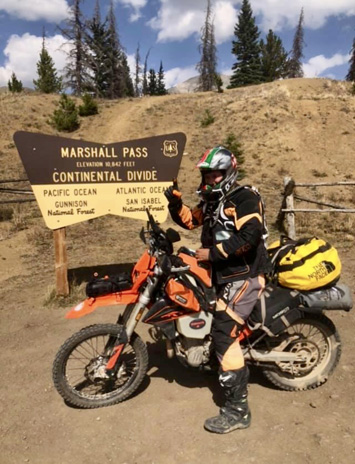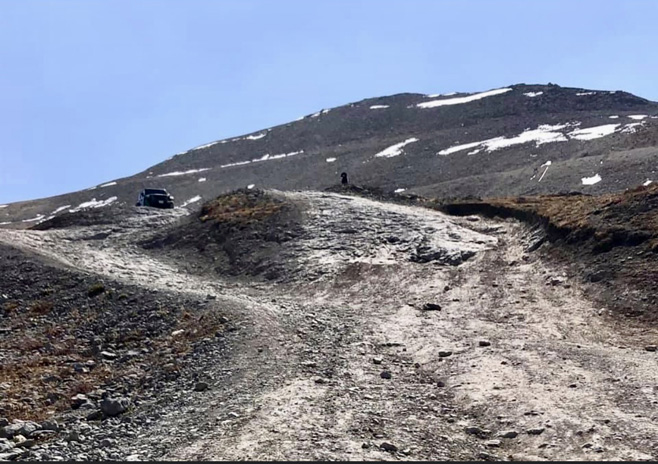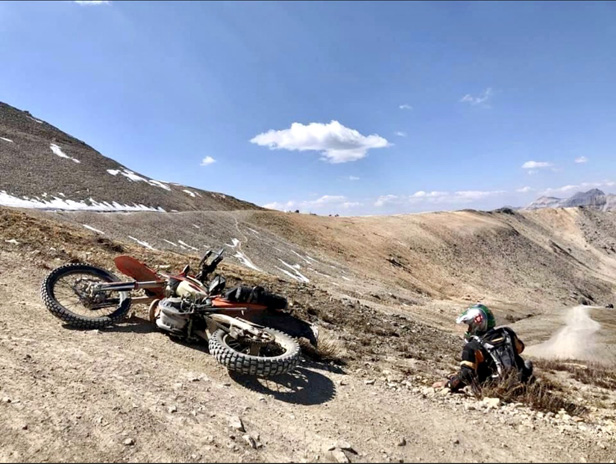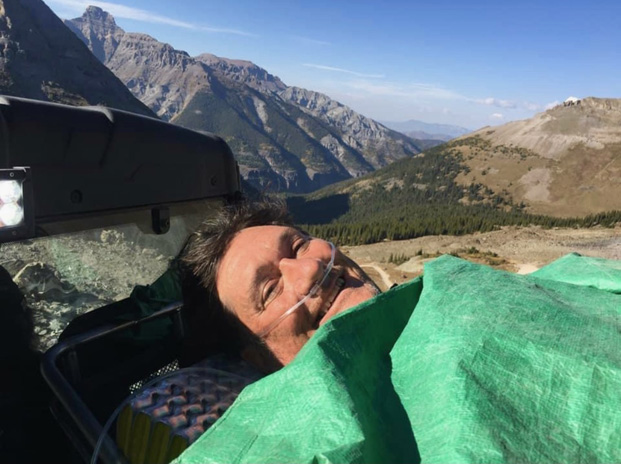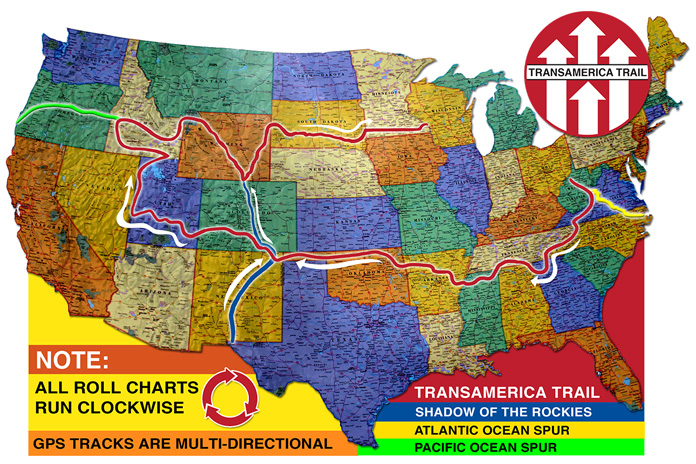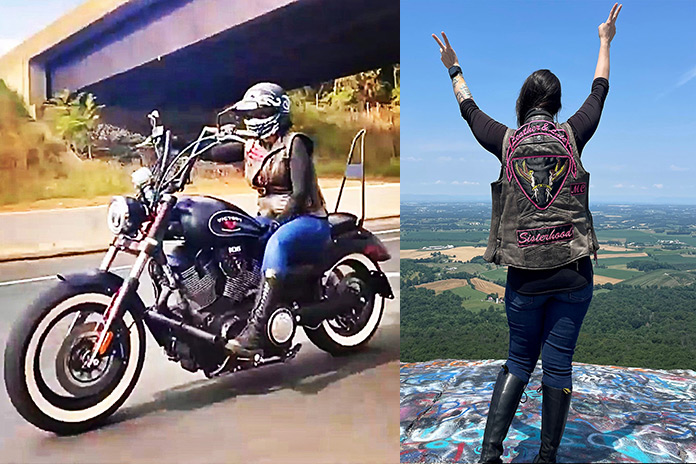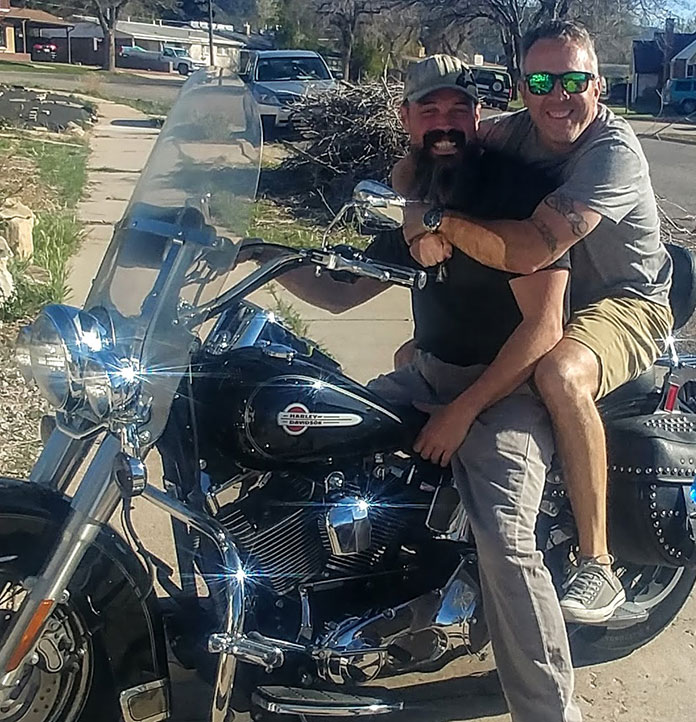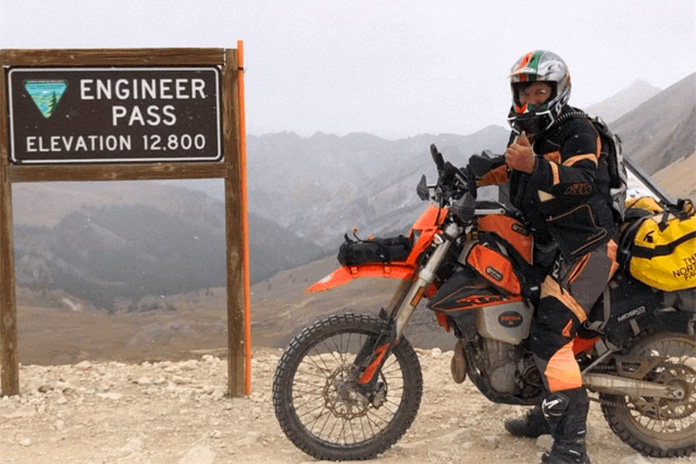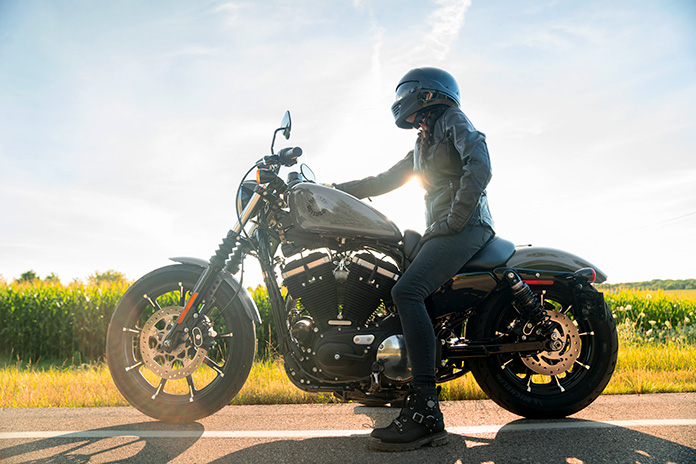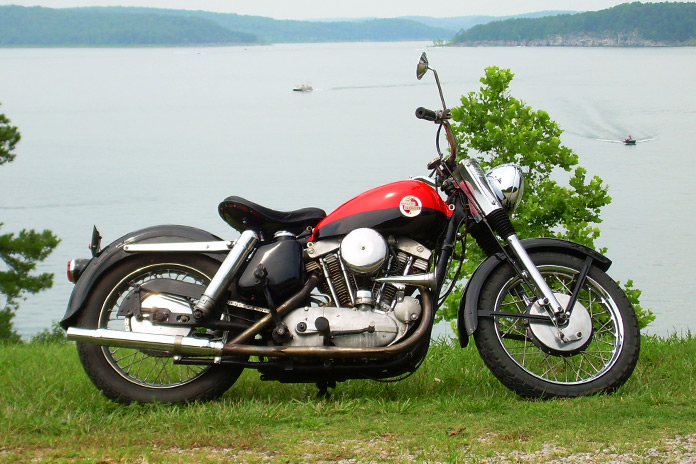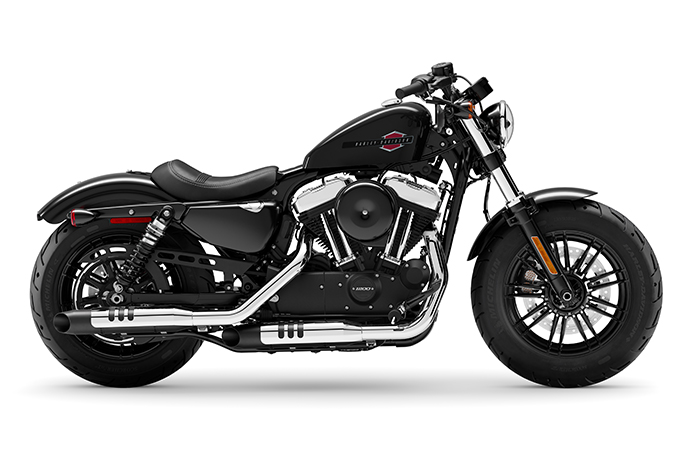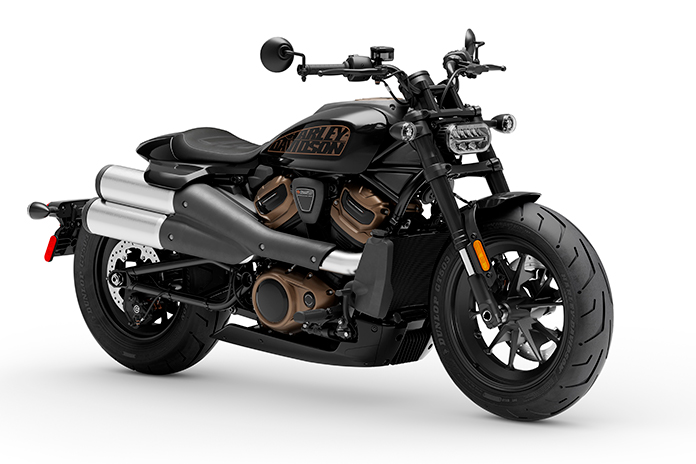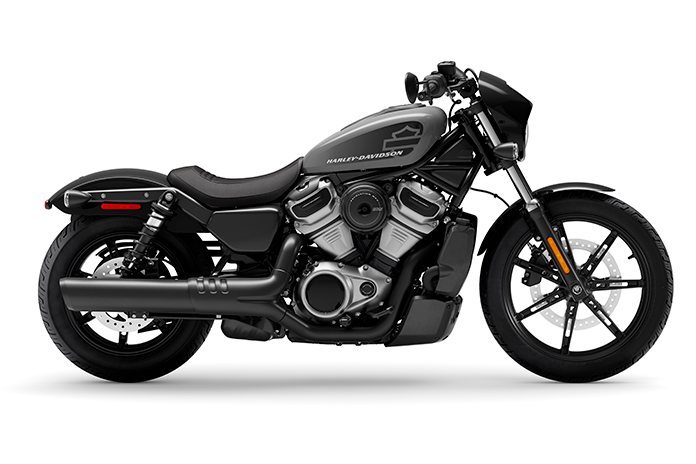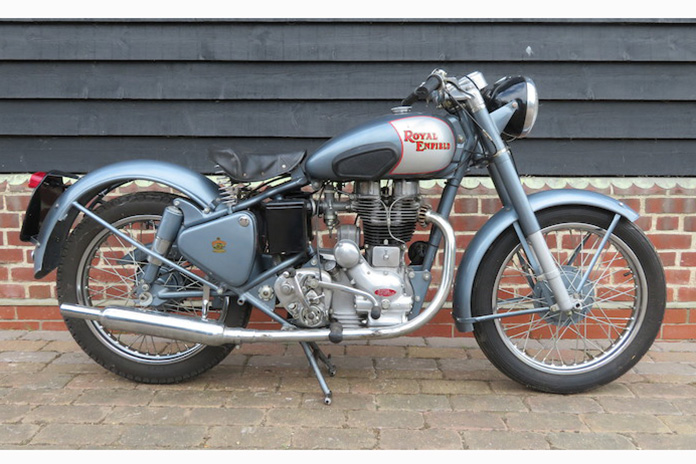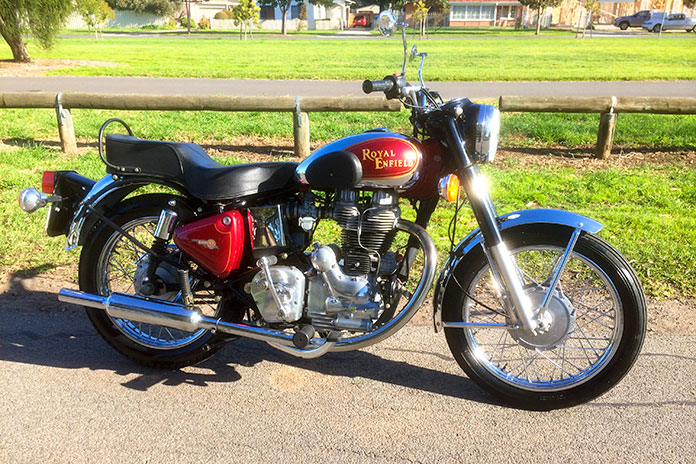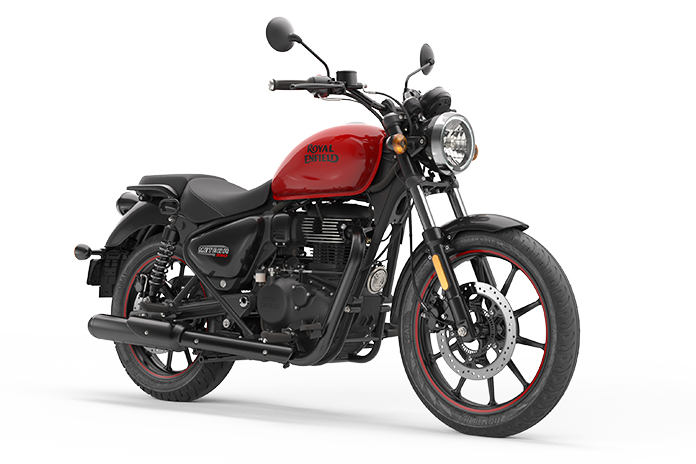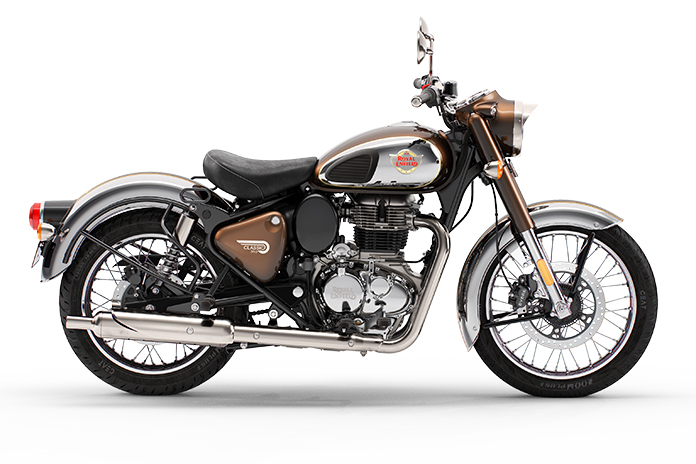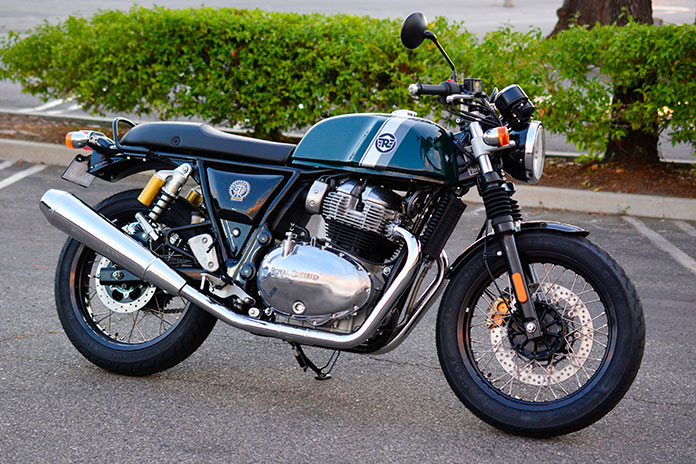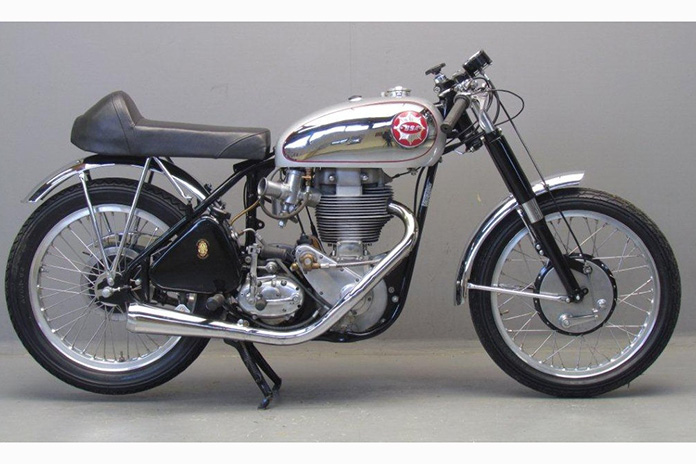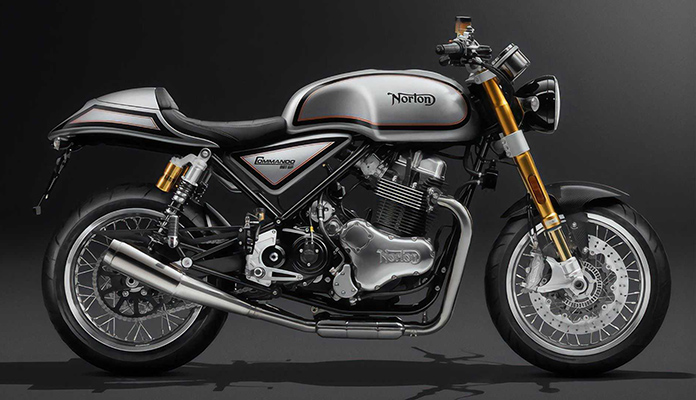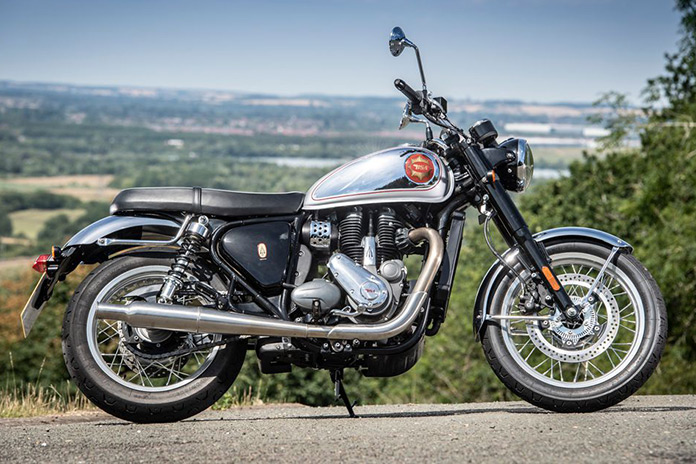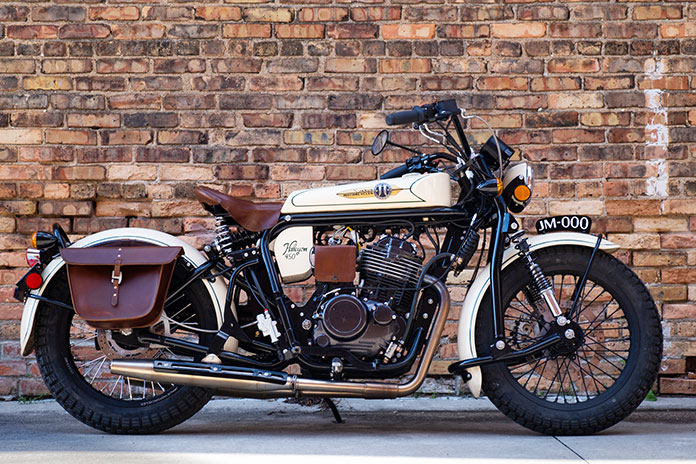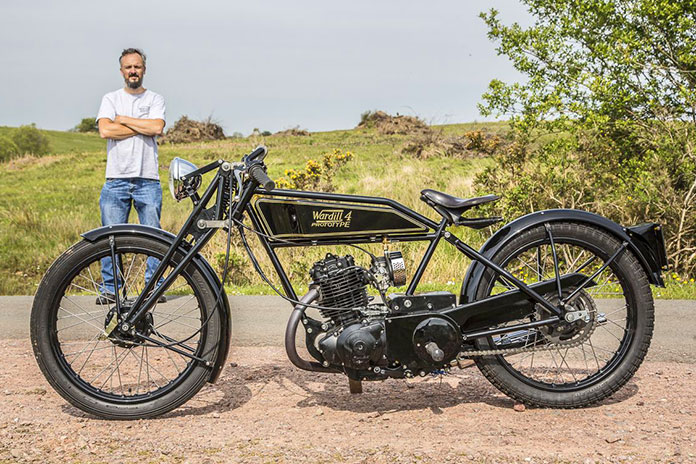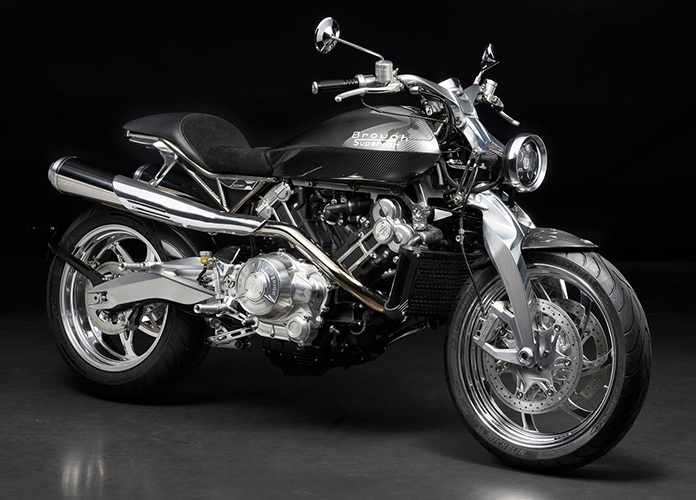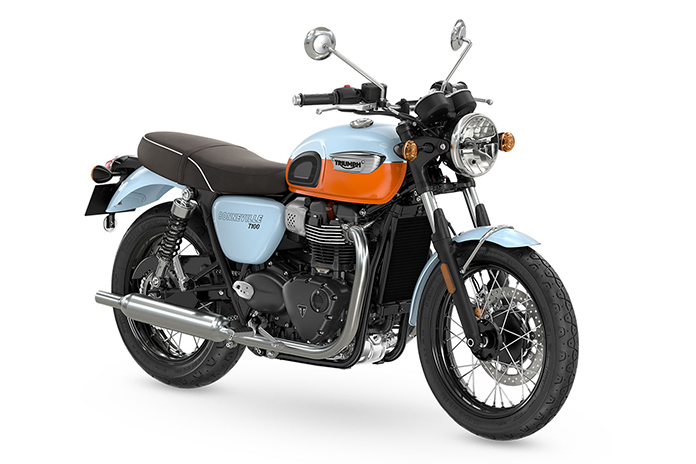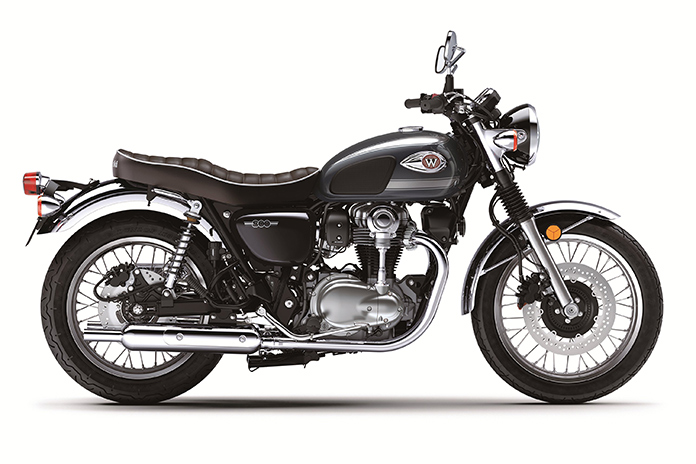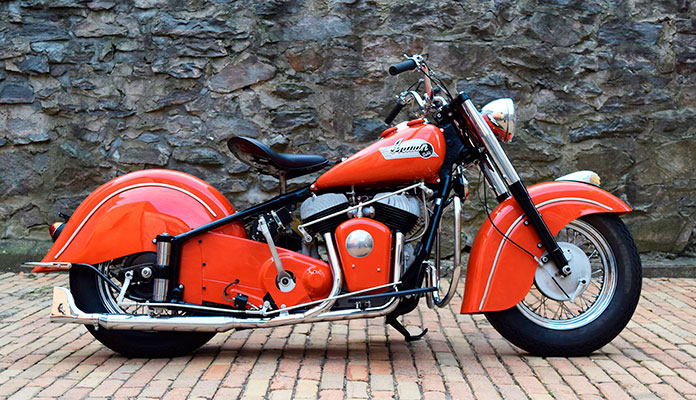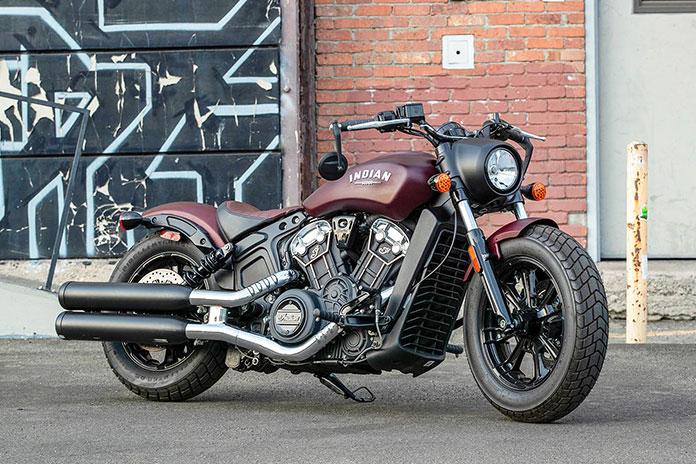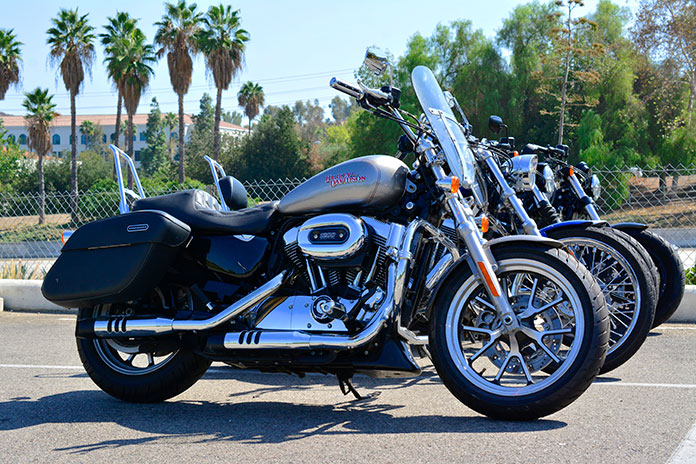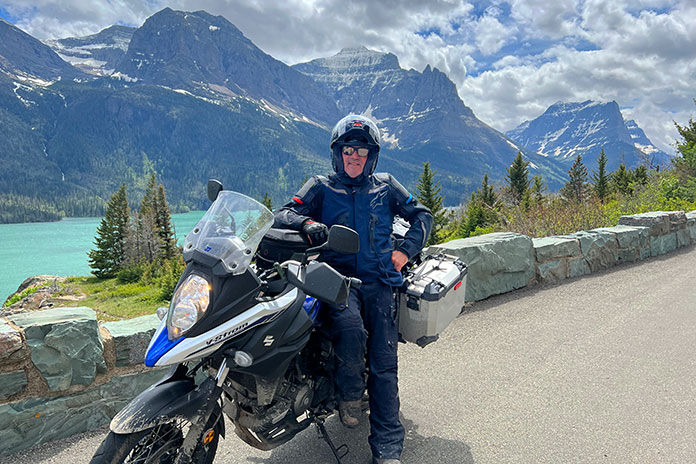
As motorcyclists, we feel drawn to the open road. As Americans, we want to take in as much of what our country has to offer as we can. And as human beings – especially if we’re of a certain age – we want to see our family and friends face-to-face, to hug them and shake their hands and hear and tell stories new and old. Phone calls and texts help us stay in touch, but they are a poor substitute for the real deal. I decided to check all the boxes with a cross-country motorcycle trip.
I live in Southern California, and I have family and friends all over this great nation, from sea to shining sea. I’ve ridden cross-country many times before, but I was overdue for a special lap around America, one where I could see the sights and visit the important people in my life without a strict agenda or schedule. When I opened a Dove chocolate and saw the advice “Live every day with no regrets, it’ll be worth it” inside the wrapper, it felt like a calling. I packed my gear and headed east.
Family Roots
Back in 1940, my grandparents loaded up their ’37 Packard with all their belongings, including my 10-year-old father, Mark, and his 7-year-old younger brother, Bernard (where I got my middle name) and headed west. Leaving Youngstown, Ohio, they made their way to Route 66 and followed it to Burbank, California, where Grandpa Seth got a welding and fabricating job for Lockheed Aircraft.
Before long, my grandparents purchased a Texaco station that became the family business. Our family still owns the building, which now houses an auto body shop. My grandparents died just before I was born, but I believe I inherited my love and innate abilities for fabricating and restoring motorcycles from my Grandpa Seth. I still use his old Wilton bench vise, hand tools, and other equipment.
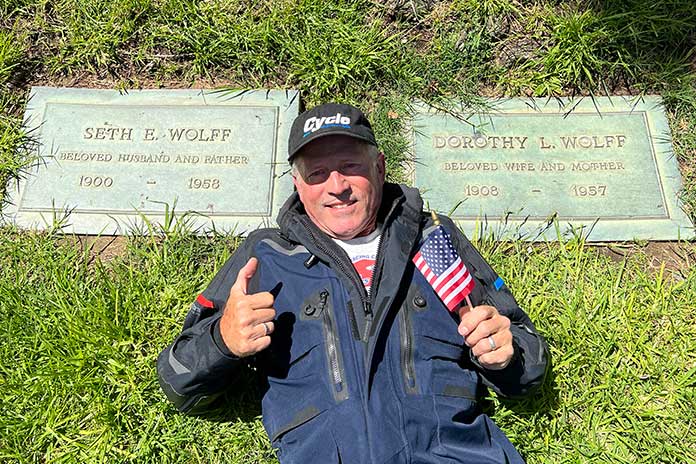
Time was of the essence with my own cross-country journey, some 82 years later. My dad was approaching his 95th birthday, and ol’ Uncle “Bud” (Bernard’s nickname) was pushing 92. They don’t travel anymore, and they hadn’t seen each other in over a decade. I decided to keep the trip a secret from Dad. My plan was to ride to New York and do a surprise video call between the aging brothers.
I left my house in Thousand Oaks, California, on Memorial Day and returned home in time to celebrate the 4th of July. Over a month and more than 10,000 miles, I passed through 33 states, visited and stayed with dozens of people who were already near and dear to my heart, and enjoyed meeting many new friends as well.
To get ready for my journey, Alpinestars and Shoei/Helmet House provided me with gear, Nelson-Rigg set me up with a waterproof duffel, and my friends at Suzuki were kind enough to loan me a 2022 V-Strom 650XT with an accessory tankbag and panniers. The V-Strom 650 is one of the best bang-for-the-buck adventure bikes out there. It fits me like a glove, has a really comfortable seat, likes to go off-road here and there, and only asked for gas in the tank and PJ1 on the chain every now and again.
Related: 2018 Suzuki V-Strom 650XT vs V-Strom 1000XT | Comparison Review
With the bike packed, I said my goodbyes and my prayers, pulled in the clutch, dropped into 1st gear, and rolled away from home. It was a surreal feeling starting a ride of this magnitude, wondering what might be in store for me.
A Cross-Country Motorcycle Trip: Eastbound and Down
Before departing on this ride, I traced a big outline of the U.S. and each of the lower 48 states on a large sheet of heavy-duty paper, and at the top I wrote “2022 Friends & Family Ride!” I kept it rolled up in a cardboard tube and used it to document my route. Along the way, I had family, friends, and other folks write notes and messages on the map.
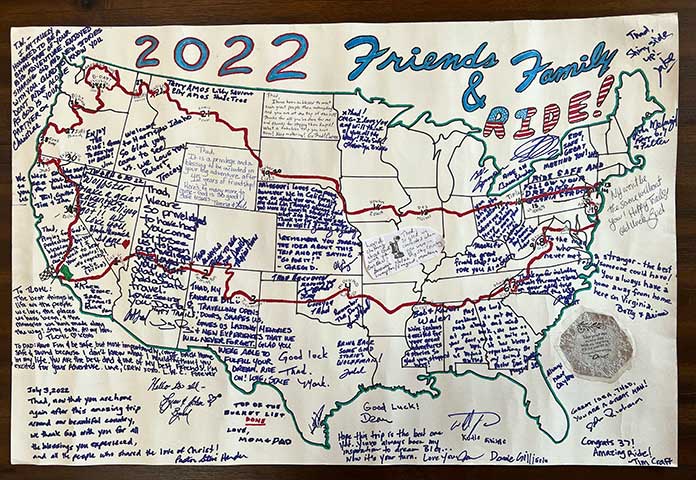
After riding across the Mojave Desert to Las Vegas, I continued northeast and rode through Zion National Park in Utah. I meandered east to Four Corners, got off my bike, and managed to be in all four states at once with my feet in Arizona and New Mexico and my hands in Utah and Colorado. In New Mexico, I visited friends in Farmington and Tucumcari. As the trip unfolded, I found that most of the time there was another friend or family member with whom I could stay within a day’s ride.
I blazed across the Texas Panhandle on my way to “McDonald Land,” the nickname for where Norm and Lucy McDonald live near Tulsa, Oklahoma. Norm is the “N” in K&N filters, which nearly everyone has run in their bikes or cars at some point. I used to pitstop there in the early ’80s when traveling around the country during my AMA roadracing days. I met the McDonalds through their son, Sam, when we were both novices in 1980. Through K&N Yamaha, Norm and Lucy sponsored countless racers over the years, with Malcolm Smith being one of the most notable. They are wonderful people whose friendship is precious to me. Staying with them again like in the good ol’ days was very special.
After visiting other friends in Memphis, Tennessee, I skipped across the tops of Mississippi, Alabama, and Georgia and made my way up into the Appalachians and onto the Blue Ridge Parkway. Rider magazine readers have seen plenty of great ride stories from this area, and now I got to do the riding!
See all of Rider‘s touring stories here.
The weather was perfect, the scenery was beautiful, and I took some side trips on the 650XT down small roads and trails. In Maggie Valley, North Carolina, I stopped at the Wheels Through Time Museum. I love old bikes and old American stuff, so this place is like heaven to me. Dale Walksler has passed, but his son Matt has taken over and is doing an awesome job keeping the museum going.
Heading North
I rode up Skyline Drive and into Virginia, where I spent a couple nights at Brian and Betty Richardson’s 19th-century sheep farm. Rider’s former editor-in-chief, Mark Tuttle, connected me with the Richardsons back in 2009, and I raced Brian’s homebuilt Moto-Electra electric bike in the TTXGP series for a few years. In 2013, we set the coast-to-coast world record for electric vehicles on the same bike by crossing the U.S. in 84.5 hours. Brian and I became good friends, and for years I’ve been telling him I would ride up to his farm one day. I finally did, and we spent a day riding together on awesome backroads.
I left the farm in the morning and was soon greeted by a dramatic change in scenery. By midday, I was taking a selfie in front of the Capitol in D.C. I wished I could help straighten things out there, but I decided I’d rather ride my motorcycle. I hightailed it out of D.C. and crossed the Delaware Bay on a ferry from Lewes, Delaware, to Cape May, New Jersey, which is the oldest resort town in America and a neat place to stay.
Another special thing about New Jersey is one of its residents: Gloria Struck, the first lady of motorcycling, who is 97 years young. I wrote a story for Rider (March 2013 issue) about Gloria and the Motor Maids, and we have been close friends for a long time. We first met years ago at Daytona Bike Week, where I noticed her Harley had Clorox bottles cut in half and strapped to the handlebar as wind deflectors. I had done that before myself, but when I found out it was Gloria’s bike and that she had ridden from New Jersey, where she had to shovel snow to get out of her driveway, I immediately developed a deep fondness and respect for this woman.
Spending a couple nights with Gloria, reminiscing and listening to her talk about riding her motorcycle, or the trike she’s going to get when she turns 100, was absolutely priceless. I highly recommend buying her book, Gloria – A Lifetime Motorcyclist: 75 Years on Two Wheels and Still Riding, which was published in 2018.
Gloria did her first solo ride to Daytona in 1951 to watch the beach races. Dick Klamfoth won that year (and also in 1949 and 1952), and as fate would have it, Dick and I became friends, and I helped him build the Daytona 200 monument, which took several years. He and his wife, Bev, are gone now, but later in my ride, I would carry on our memories by visiting their daughter, Christy, in Ohio.
The Big Apple
From Clifton, New Jersey, I passed under the Hudson River through the Lincoln Tunnel and popped out in midtown Manhattan. Riding around the Big Apple in the rain was quite an adventure. After taking the Queensboro Bridge over the East River to Long Island City, I finally arrived at the easternmost point of my journey and visited Uncle Bud. It had been hard to keep the secret, but when we surprised my dad with a FaceTime call from his brother and son, it was a very special family moment.
Saying goodbye to good ol’ Uncle Bud and wondering if it would be the last time we’d see each other face-to-face was emotional, but I laughed as always when he said, “See ya later, alligator!”
Crossing Manhattan again, I was officially on my way home. It felt good to make it out of the big city and know the rest of the ride would be mostly rural countrysides and small towns.
Westward Ho!
In our family’s hometown of Youngstown, Ohio, I stayed with my cousin John. We had never met and had fun getting to know one another. Using Bud’s recently sketched picture of the family home, we found the now-abandoned dwelling where they once lived. It was like searching for hidden treasure with a map Bud drew from his memory of a place he left at the age of 7! John showed me around, and I imagined my family living there in the old steel town’s heyday. I thought about them in the old Packard driving away from the house on Worthington Street for the last time, looking back at what was being left behind and then looking forward, wondering what life would be like in California.
From Youngstown, I rode southwest to Columbus, where I visited the AMA Hall of Fame Museum and then popped in on Bruce Linsday. Bruce is a top guy in the antique motorcycle world with an unbelievable collection of early American motorcycles. Years ago, when we were in Death Valley riding our old Harleys, he invited me to stop by his place so I could ride a particular old Harley dating back to 1905. The factory in Milwaukee has one in its museum, and Bruce has the other one. These two bikes are the oldest Harleys in existence. The factory’s bike is under glass and will never be ridden, so I was fortunate enough to be able to ride the oldest running Harley there is! Quite an experience.
After a stop in Des Moines, Iowa, I continued west to South Dakota. In 2009, I attended the V-Strom Rally in Rapid City on assignment for Rider (April 2010 issue) and made friends with resident V-Strom rider Carter Kirk. He let me borrow his bike for the rally, and I had a wonderful time exploring the Black Hills. Since I was traveling on a new V-Strom 650XT on my family-and-friends tour, I had to visit Carter.
With him on his old V-Strom and me on my new one, we spent a day riding and sightseeing. We stood at the base of Mount Rushmore and took in the majesty of one of this country’s most patriotic treasures. After dinner in Sturgis, we capped off an awesome day with a night ride home through pouring rain and an unbelievable lightning show. When we made it home, I had a good laugh when Carter asked me if I was worried during the ride. I tried to act like I wasn’t.
See all of Rider‘s Suzuki coverage here.
After visiting Devils Tower in Wyoming, I continued northwest into Montana. I love this part of the country, and after riding through some more open grassland, I was finally rewarded with a view of the snowcapped Rocky Mountains. I rode the incomparable Going-to-the-Sun Road in Glacier National Park, then made my way into Idaho, where I visited my nephew, Robert, and his wife, Tracy, in the little community of Harrison. They recently moved there from our hometown in Southern California to a little house overlooking a lake.
Farther west, I enjoyed riding the Cascade loop in Washington with all the forest roads and the surprising views of white-topped volcanic mountains that appear out of nowhere. After a stop to visit my sister-in-law Jill in Bend, Oregon, I finally saw what I was waiting for: the beautiful blue Pacific Ocean. I punched my fist into the air and hollered “Yahoo!” inside my helmet. I love riding along the western edge of our country.
The Homestretch of My Cross-Country Motorcycle Trip
Back in California, my next stop was Eureka, a nice little coastal town where I stayed with my Uncle Jim and Aunt Jan and visited my cousin Bill. At this point in the trip, I had seen all my living relatives and felt I had accomplished what I set out to do.
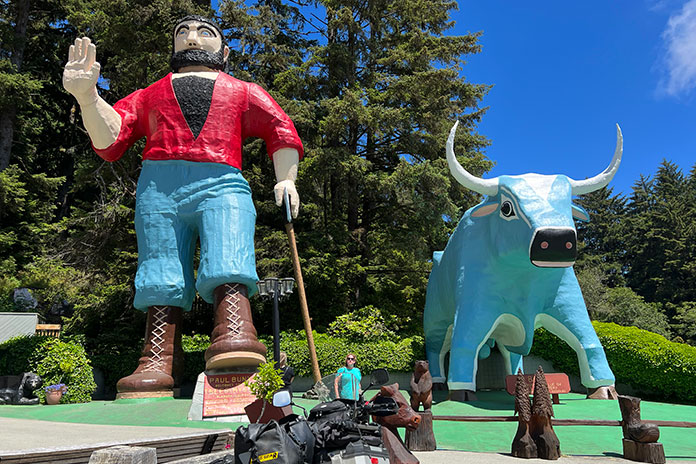
But there were more miles to cover, such as riding among the majestic coastal redwoods before heading inland to visit Lassen Volcanic National Park in northeastern California. Zigzagging my way through the gold country of the Sierra Nevada, around Lake Tahoe, and past Mammoth Mountain. And then finally crossing the Mojave Desert again to get home.
What a feeling to turn the corner and know this journey had come to an end. There in the driveway was my wife, Jody, and my daughter, Kelly, waiting for me with open arms. I hadn’t even gotten off the bike before the tear-filled hugs began. Wow, what a feeling!
I arrived home in time for my dad’s 95th birthday, and he ended up passing away peacefully two short weeks later. The timing for this trip was perfect, and I’m glad I was able to make it happen rather than make excuses. In the end, our faith, family, friends, and the memories we’ve made (many with handlebars in hand) are all we have. Nothing else matters.
Don’t wait. Just go.
The post Chasing My Heritage on a Cross-Country Motorcycle Trip first appeared on Rider Magazine.
Source: RiderMagazine.com

